Electric Vehicle Charger Analysis
VerifiedAdded on 2020/05/08
|33
|10248
|216
AI Summary
This assignment delves into a research paper detailing the design of an electric vehicle (EV) charger. Students are tasked with evaluating the paper's findings on the charger's efficiency, power transfer capabilities, and integration within the overall EV system. The analysis should encompass the research question, design considerations, key findings, and any identified gaps in the existing literature.
Contribute Materials
Your contribution can guide someone’s learning journey. Share your
documents today.
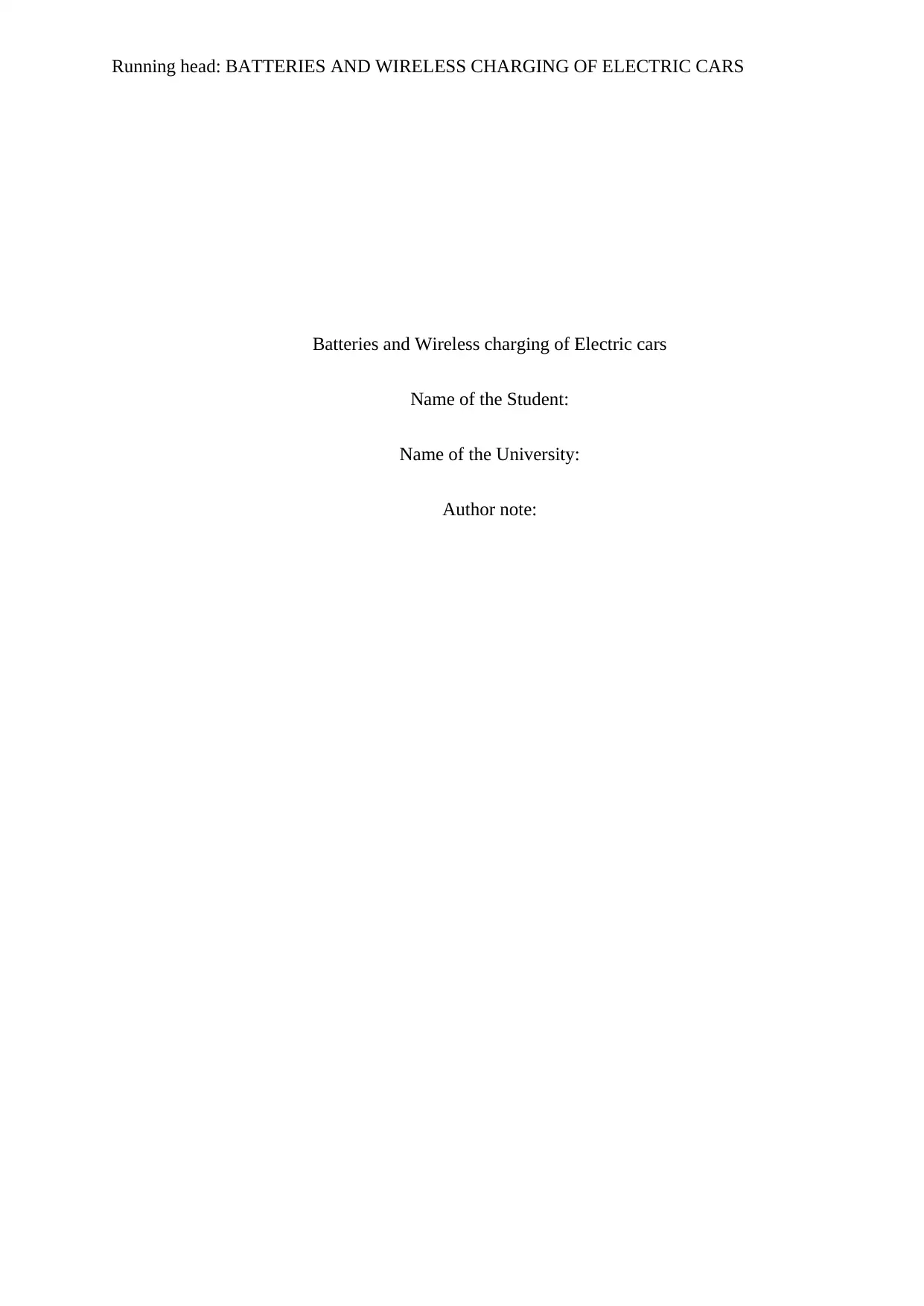
Running head: BATTERIES AND WIRELESS CHARGING OF ELECTRIC CARS
Batteries and Wireless charging of Electric cars
Name of the Student:
Name of the University:
Author note:
Batteries and Wireless charging of Electric cars
Name of the Student:
Name of the University:
Author note:
Secure Best Marks with AI Grader
Need help grading? Try our AI Grader for instant feedback on your assignments.
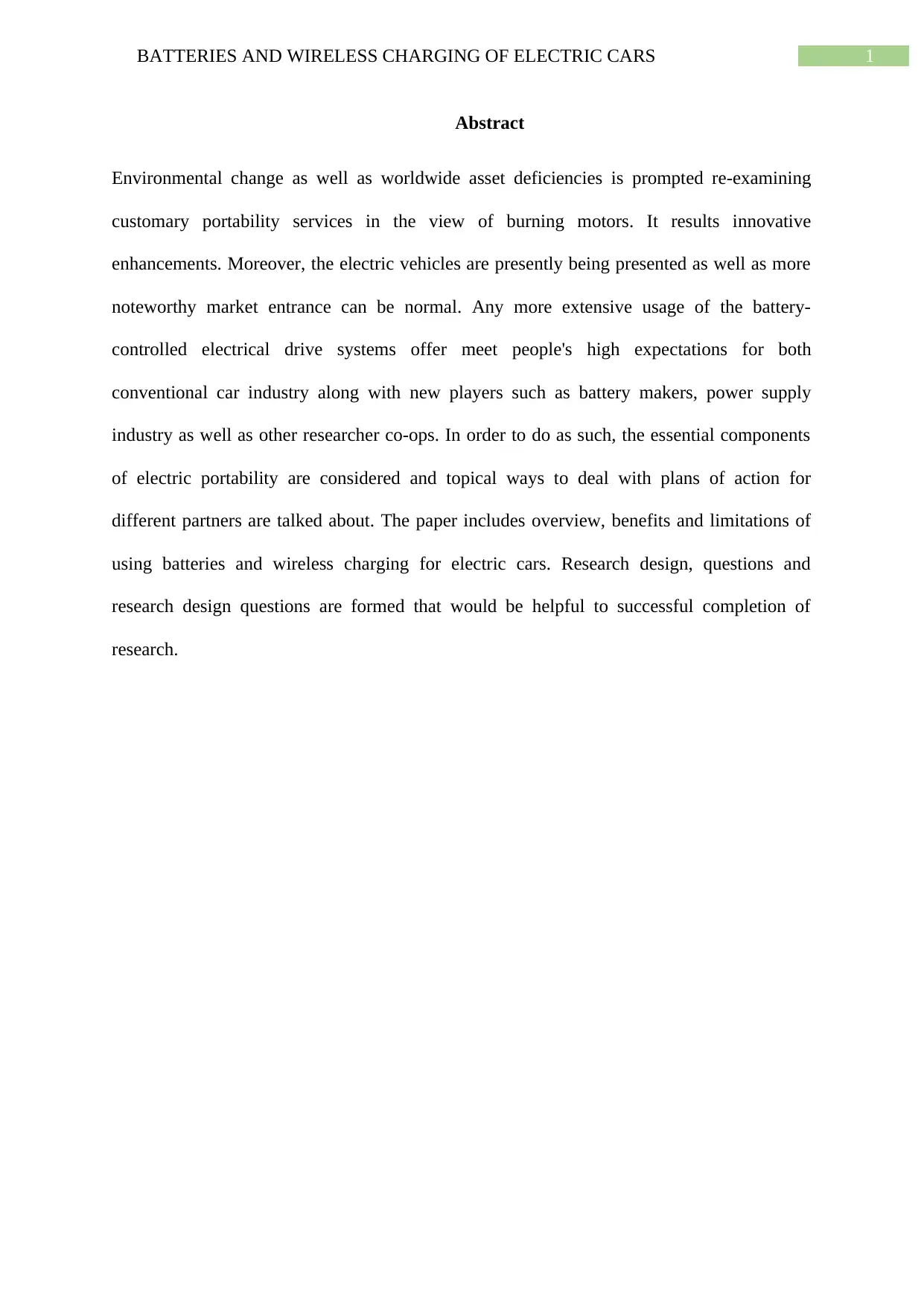
1BATTERIES AND WIRELESS CHARGING OF ELECTRIC CARS
Abstract
Environmental change as well as worldwide asset deficiencies is prompted re-examining
customary portability services in the view of burning motors. It results innovative
enhancements. Moreover, the electric vehicles are presently being presented as well as more
noteworthy market entrance can be normal. Any more extensive usage of the battery-
controlled electrical drive systems offer meet people's high expectations for both
conventional car industry along with new players such as battery makers, power supply
industry as well as other researcher co-ops. In order to do as such, the essential components
of electric portability are considered and topical ways to deal with plans of action for
different partners are talked about. The paper includes overview, benefits and limitations of
using batteries and wireless charging for electric cars. Research design, questions and
research design questions are formed that would be helpful to successful completion of
research.
Abstract
Environmental change as well as worldwide asset deficiencies is prompted re-examining
customary portability services in the view of burning motors. It results innovative
enhancements. Moreover, the electric vehicles are presently being presented as well as more
noteworthy market entrance can be normal. Any more extensive usage of the battery-
controlled electrical drive systems offer meet people's high expectations for both
conventional car industry along with new players such as battery makers, power supply
industry as well as other researcher co-ops. In order to do as such, the essential components
of electric portability are considered and topical ways to deal with plans of action for
different partners are talked about. The paper includes overview, benefits and limitations of
using batteries and wireless charging for electric cars. Research design, questions and
research design questions are formed that would be helpful to successful completion of
research.
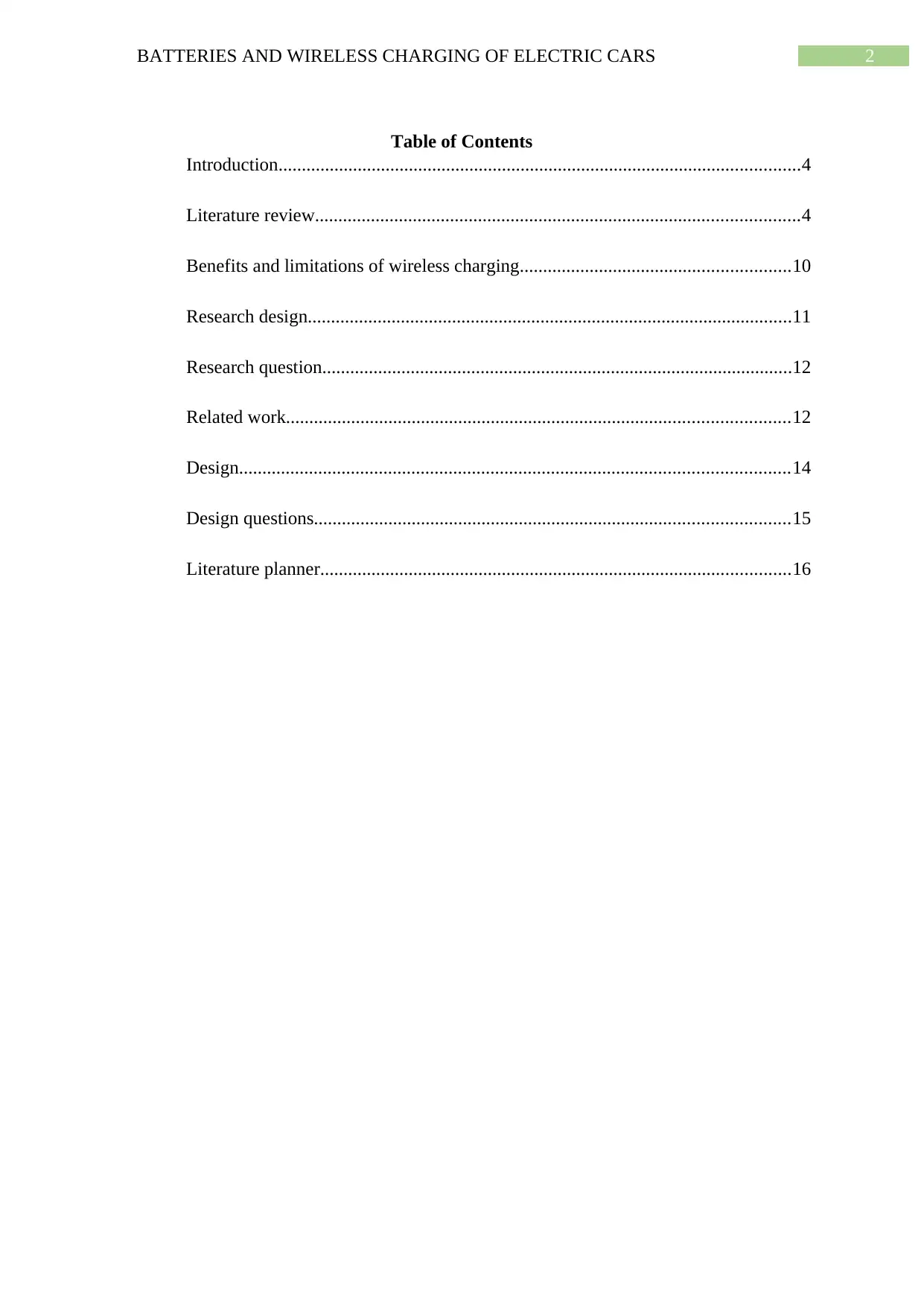
2BATTERIES AND WIRELESS CHARGING OF ELECTRIC CARS
Table of Contents
Introduction................................................................................................................4
Literature review........................................................................................................4
Benefits and limitations of wireless charging..........................................................10
Research design........................................................................................................11
Research question.....................................................................................................12
Related work............................................................................................................12
Design......................................................................................................................14
Design questions......................................................................................................15
Literature planner.....................................................................................................16
Table of Contents
Introduction................................................................................................................4
Literature review........................................................................................................4
Benefits and limitations of wireless charging..........................................................10
Research design........................................................................................................11
Research question.....................................................................................................12
Related work............................................................................................................12
Design......................................................................................................................14
Design questions......................................................................................................15
Literature planner.....................................................................................................16
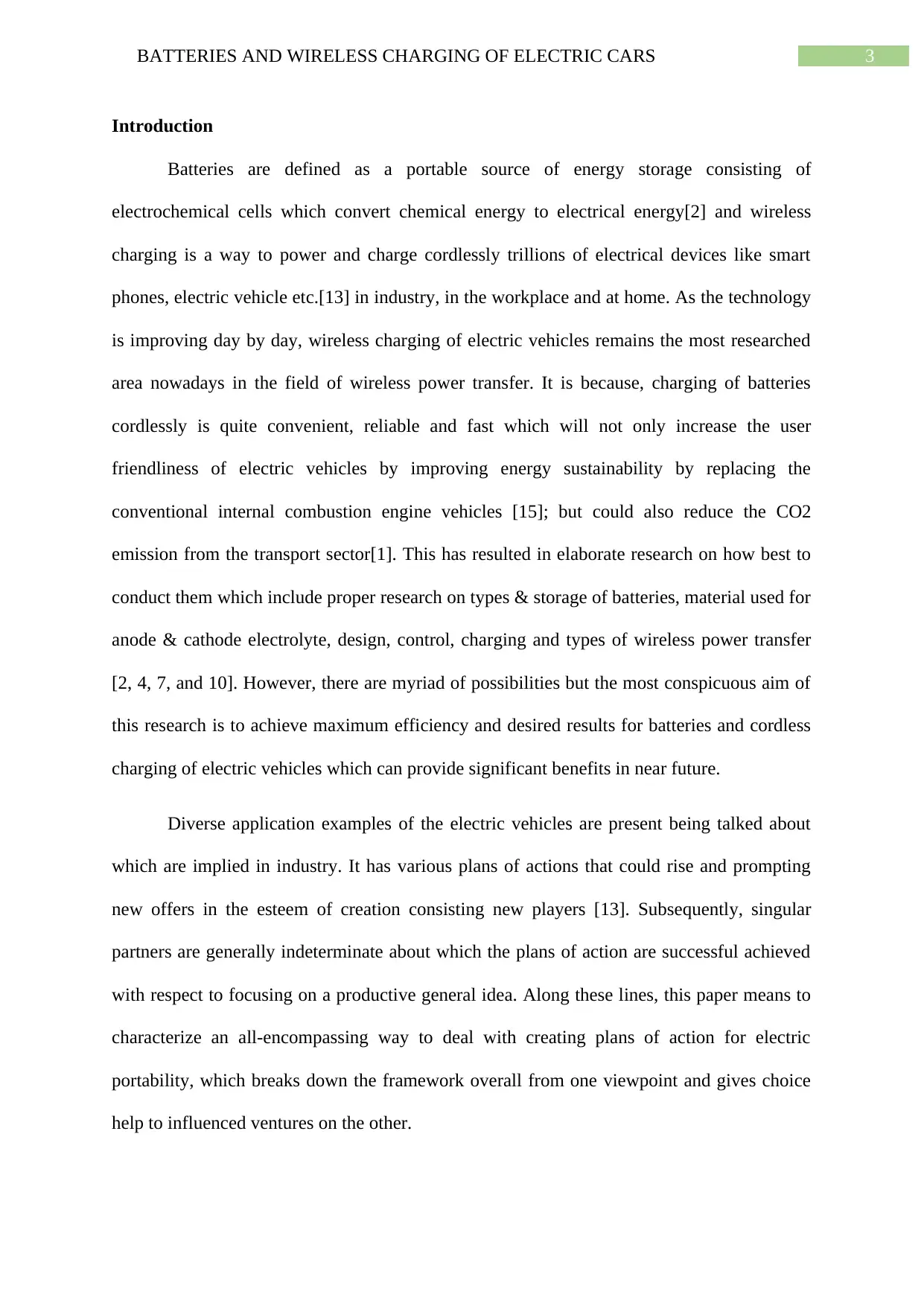
3BATTERIES AND WIRELESS CHARGING OF ELECTRIC CARS
Introduction
Batteries are defined as a portable source of energy storage consisting of
electrochemical cells which convert chemical energy to electrical energy[2] and wireless
charging is a way to power and charge cordlessly trillions of electrical devices like smart
phones, electric vehicle etc.[13] in industry, in the workplace and at home. As the technology
is improving day by day, wireless charging of electric vehicles remains the most researched
area nowadays in the field of wireless power transfer. It is because, charging of batteries
cordlessly is quite convenient, reliable and fast which will not only increase the user
friendliness of electric vehicles by improving energy sustainability by replacing the
conventional internal combustion engine vehicles [15]; but could also reduce the CO2
emission from the transport sector[1]. This has resulted in elaborate research on how best to
conduct them which include proper research on types & storage of batteries, material used for
anode & cathode electrolyte, design, control, charging and types of wireless power transfer
[2, 4, 7, and 10]. However, there are myriad of possibilities but the most conspicuous aim of
this research is to achieve maximum efficiency and desired results for batteries and cordless
charging of electric vehicles which can provide significant benefits in near future.
Diverse application examples of the electric vehicles are present being talked about
which are implied in industry. It has various plans of actions that could rise and prompting
new offers in the esteem of creation consisting new players [13]. Subsequently, singular
partners are generally indeterminate about which the plans of action are successful achieved
with respect to focusing on a productive general idea. Along these lines, this paper means to
characterize an all-encompassing way to deal with creating plans of action for electric
portability, which breaks down the framework overall from one viewpoint and gives choice
help to influenced ventures on the other.
Introduction
Batteries are defined as a portable source of energy storage consisting of
electrochemical cells which convert chemical energy to electrical energy[2] and wireless
charging is a way to power and charge cordlessly trillions of electrical devices like smart
phones, electric vehicle etc.[13] in industry, in the workplace and at home. As the technology
is improving day by day, wireless charging of electric vehicles remains the most researched
area nowadays in the field of wireless power transfer. It is because, charging of batteries
cordlessly is quite convenient, reliable and fast which will not only increase the user
friendliness of electric vehicles by improving energy sustainability by replacing the
conventional internal combustion engine vehicles [15]; but could also reduce the CO2
emission from the transport sector[1]. This has resulted in elaborate research on how best to
conduct them which include proper research on types & storage of batteries, material used for
anode & cathode electrolyte, design, control, charging and types of wireless power transfer
[2, 4, 7, and 10]. However, there are myriad of possibilities but the most conspicuous aim of
this research is to achieve maximum efficiency and desired results for batteries and cordless
charging of electric vehicles which can provide significant benefits in near future.
Diverse application examples of the electric vehicles are present being talked about
which are implied in industry. It has various plans of actions that could rise and prompting
new offers in the esteem of creation consisting new players [13]. Subsequently, singular
partners are generally indeterminate about which the plans of action are successful achieved
with respect to focusing on a productive general idea. Along these lines, this paper means to
characterize an all-encompassing way to deal with creating plans of action for electric
portability, which breaks down the framework overall from one viewpoint and gives choice
help to influenced ventures on the other.
Secure Best Marks with AI Grader
Need help grading? Try our AI Grader for instant feedback on your assignments.
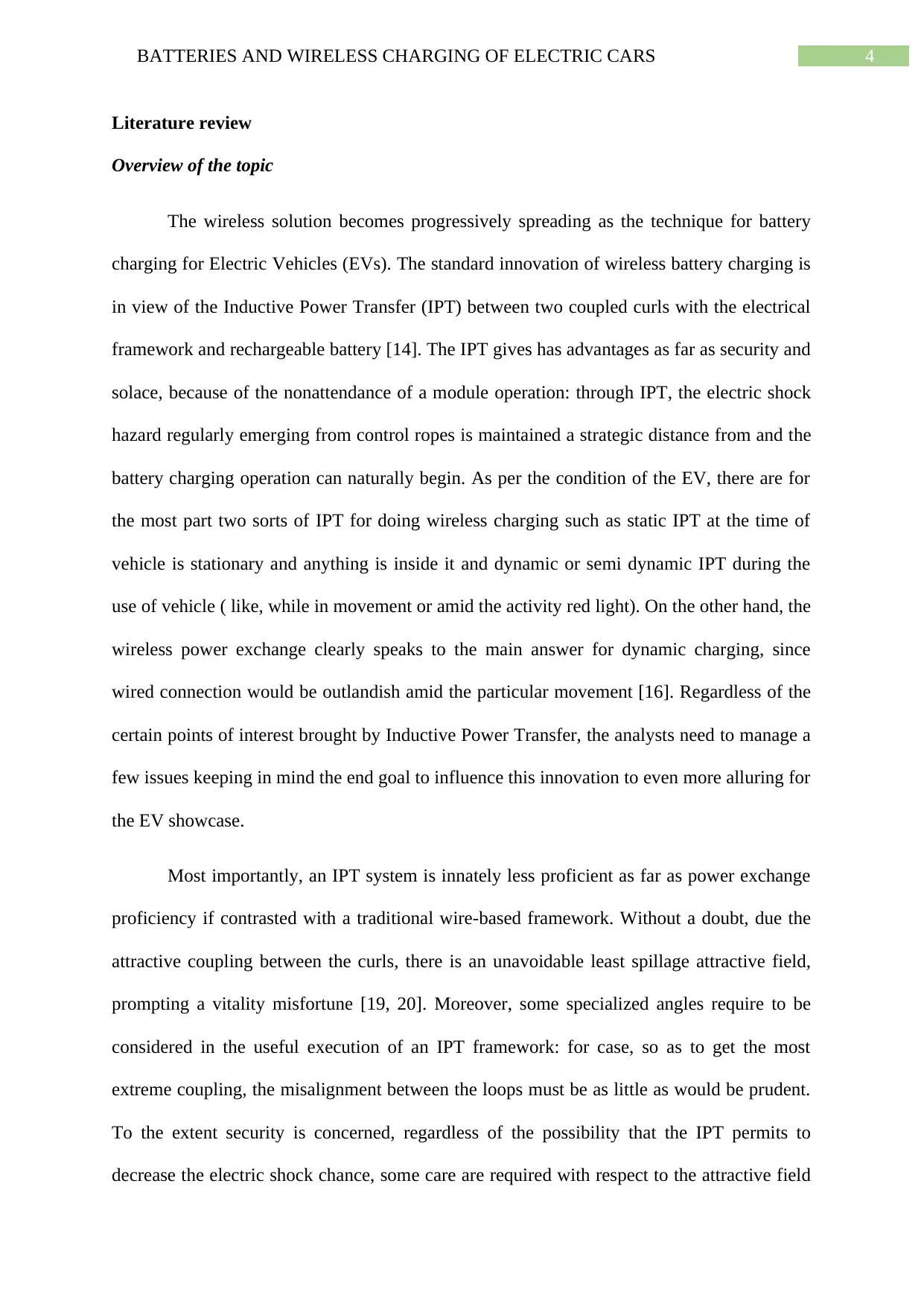
4BATTERIES AND WIRELESS CHARGING OF ELECTRIC CARS
Literature review
Overview of the topic
The wireless solution becomes progressively spreading as the technique for battery
charging for Electric Vehicles (EVs). The standard innovation of wireless battery charging is
in view of the Inductive Power Transfer (IPT) between two coupled curls with the electrical
framework and rechargeable battery [14]. The IPT gives has advantages as far as security and
solace, because of the nonattendance of a module operation: through IPT, the electric shock
hazard regularly emerging from control ropes is maintained a strategic distance from and the
battery charging operation can naturally begin. As per the condition of the EV, there are for
the most part two sorts of IPT for doing wireless charging such as static IPT at the time of
vehicle is stationary and anything is inside it and dynamic or semi dynamic IPT during the
use of vehicle ( like, while in movement or amid the activity red light). On the other hand, the
wireless power exchange clearly speaks to the main answer for dynamic charging, since
wired connection would be outlandish amid the particular movement [16]. Regardless of the
certain points of interest brought by Inductive Power Transfer, the analysts need to manage a
few issues keeping in mind the end goal to influence this innovation to even more alluring for
the EV showcase.
Most importantly, an IPT system is innately less proficient as far as power exchange
proficiency if contrasted with a traditional wire-based framework. Without a doubt, due the
attractive coupling between the curls, there is an unavoidable least spillage attractive field,
prompting a vitality misfortune [19, 20]. Moreover, some specialized angles require to be
considered in the useful execution of an IPT framework: for case, so as to get the most
extreme coupling, the misalignment between the loops must be as little as would be prudent.
To the extent security is concerned, regardless of the possibility that the IPT permits to
decrease the electric shock chance, some care are required with respect to the attractive field
Literature review
Overview of the topic
The wireless solution becomes progressively spreading as the technique for battery
charging for Electric Vehicles (EVs). The standard innovation of wireless battery charging is
in view of the Inductive Power Transfer (IPT) between two coupled curls with the electrical
framework and rechargeable battery [14]. The IPT gives has advantages as far as security and
solace, because of the nonattendance of a module operation: through IPT, the electric shock
hazard regularly emerging from control ropes is maintained a strategic distance from and the
battery charging operation can naturally begin. As per the condition of the EV, there are for
the most part two sorts of IPT for doing wireless charging such as static IPT at the time of
vehicle is stationary and anything is inside it and dynamic or semi dynamic IPT during the
use of vehicle ( like, while in movement or amid the activity red light). On the other hand, the
wireless power exchange clearly speaks to the main answer for dynamic charging, since
wired connection would be outlandish amid the particular movement [16]. Regardless of the
certain points of interest brought by Inductive Power Transfer, the analysts need to manage a
few issues keeping in mind the end goal to influence this innovation to even more alluring for
the EV showcase.
Most importantly, an IPT system is innately less proficient as far as power exchange
proficiency if contrasted with a traditional wire-based framework. Without a doubt, due the
attractive coupling between the curls, there is an unavoidable least spillage attractive field,
prompting a vitality misfortune [19, 20]. Moreover, some specialized angles require to be
considered in the useful execution of an IPT framework: for case, so as to get the most
extreme coupling, the misalignment between the loops must be as little as would be prudent.
To the extent security is concerned, regardless of the possibility that the IPT permits to
decrease the electric shock chance, some care are required with respect to the attractive field
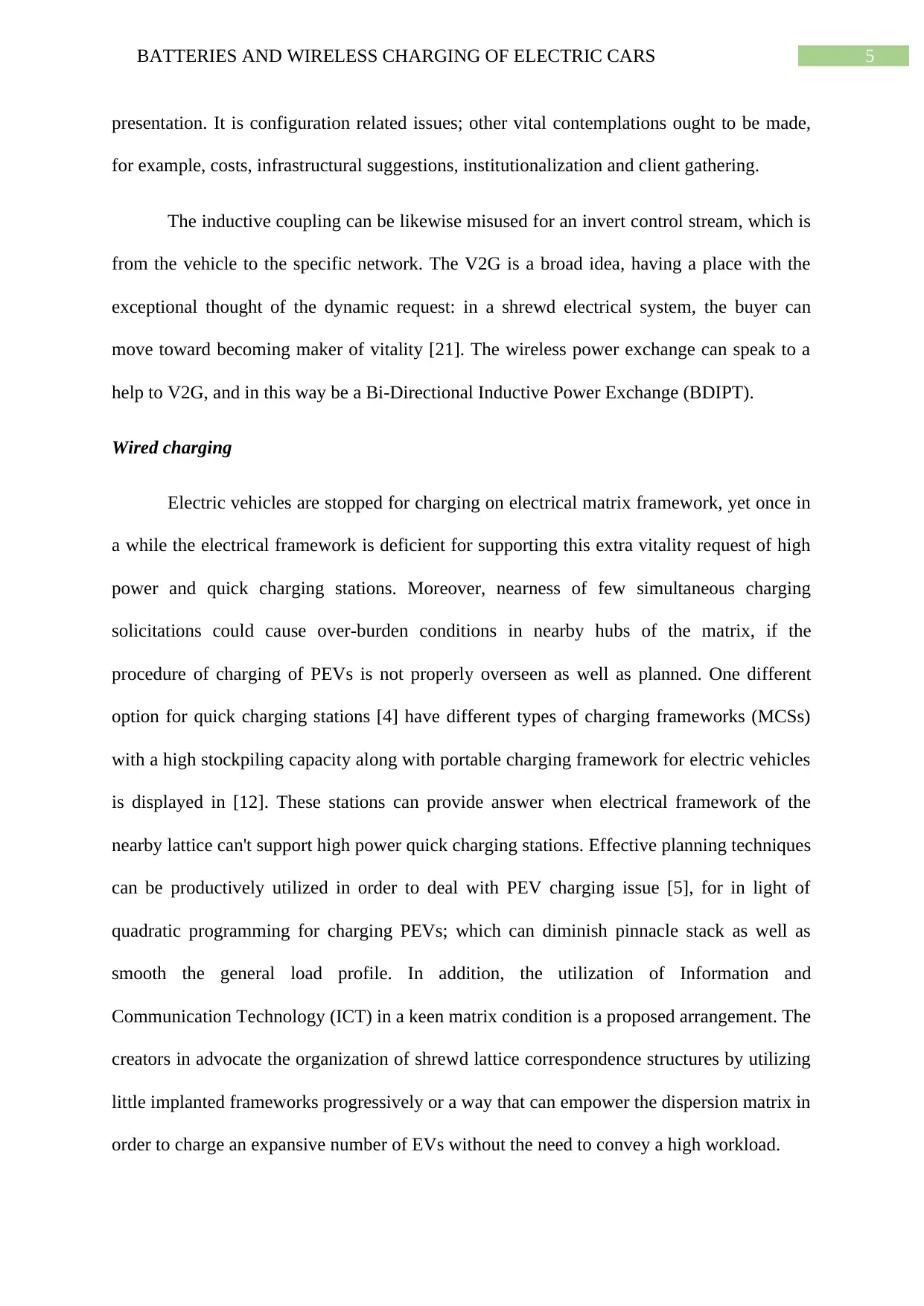
5BATTERIES AND WIRELESS CHARGING OF ELECTRIC CARS
presentation. It is configuration related issues; other vital contemplations ought to be made,
for example, costs, infrastructural suggestions, institutionalization and client gathering.
The inductive coupling can be likewise misused for an invert control stream, which is
from the vehicle to the specific network. The V2G is a broad idea, having a place with the
exceptional thought of the dynamic request: in a shrewd electrical system, the buyer can
move toward becoming maker of vitality [21]. The wireless power exchange can speak to a
help to V2G, and in this way be a Bi-Directional Inductive Power Exchange (BDIPT).
Wired charging
Electric vehicles are stopped for charging on electrical matrix framework, yet once in
a while the electrical framework is deficient for supporting this extra vitality request of high
power and quick charging stations. Moreover, nearness of few simultaneous charging
solicitations could cause over-burden conditions in nearby hubs of the matrix, if the
procedure of charging of PEVs is not properly overseen as well as planned. One different
option for quick charging stations [4] have different types of charging frameworks (MCSs)
with a high stockpiling capacity along with portable charging framework for electric vehicles
is displayed in [12]. These stations can provide answer when electrical framework of the
nearby lattice can't support high power quick charging stations. Effective planning techniques
can be productively utilized in order to deal with PEV charging issue [5], for in light of
quadratic programming for charging PEVs; which can diminish pinnacle stack as well as
smooth the general load profile. In addition, the utilization of Information and
Communication Technology (ICT) in a keen matrix condition is a proposed arrangement. The
creators in advocate the organization of shrewd lattice correspondence structures by utilizing
little implanted frameworks progressively or a way that can empower the dispersion matrix in
order to charge an expansive number of EVs without the need to convey a high workload.
presentation. It is configuration related issues; other vital contemplations ought to be made,
for example, costs, infrastructural suggestions, institutionalization and client gathering.
The inductive coupling can be likewise misused for an invert control stream, which is
from the vehicle to the specific network. The V2G is a broad idea, having a place with the
exceptional thought of the dynamic request: in a shrewd electrical system, the buyer can
move toward becoming maker of vitality [21]. The wireless power exchange can speak to a
help to V2G, and in this way be a Bi-Directional Inductive Power Exchange (BDIPT).
Wired charging
Electric vehicles are stopped for charging on electrical matrix framework, yet once in
a while the electrical framework is deficient for supporting this extra vitality request of high
power and quick charging stations. Moreover, nearness of few simultaneous charging
solicitations could cause over-burden conditions in nearby hubs of the matrix, if the
procedure of charging of PEVs is not properly overseen as well as planned. One different
option for quick charging stations [4] have different types of charging frameworks (MCSs)
with a high stockpiling capacity along with portable charging framework for electric vehicles
is displayed in [12]. These stations can provide answer when electrical framework of the
nearby lattice can't support high power quick charging stations. Effective planning techniques
can be productively utilized in order to deal with PEV charging issue [5], for in light of
quadratic programming for charging PEVs; which can diminish pinnacle stack as well as
smooth the general load profile. In addition, the utilization of Information and
Communication Technology (ICT) in a keen matrix condition is a proposed arrangement. The
creators in advocate the organization of shrewd lattice correspondence structures by utilizing
little implanted frameworks progressively or a way that can empower the dispersion matrix in
order to charge an expansive number of EVs without the need to convey a high workload.
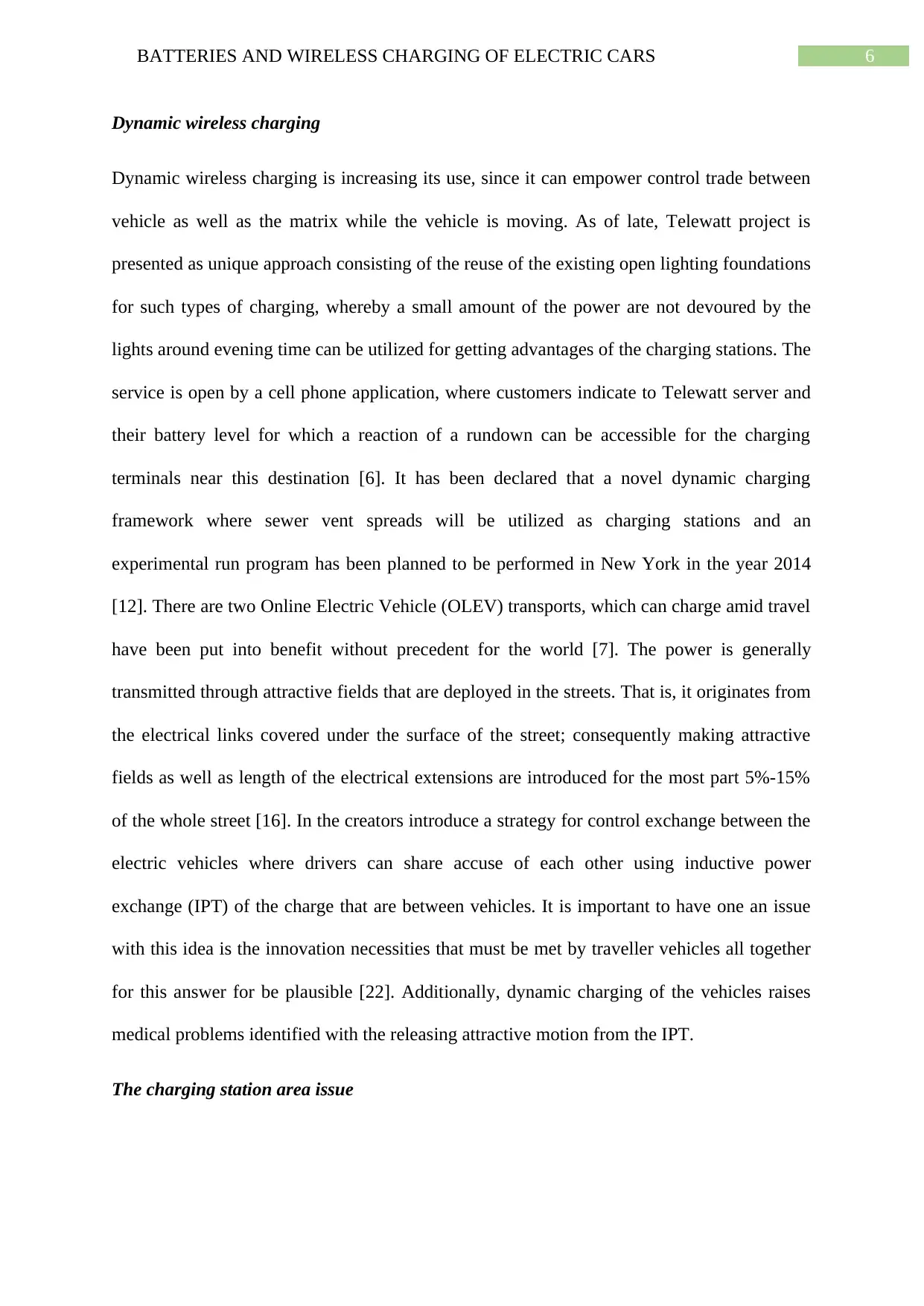
6BATTERIES AND WIRELESS CHARGING OF ELECTRIC CARS
Dynamic wireless charging
Dynamic wireless charging is increasing its use, since it can empower control trade between
vehicle as well as the matrix while the vehicle is moving. As of late, Telewatt project is
presented as unique approach consisting of the reuse of the existing open lighting foundations
for such types of charging, whereby a small amount of the power are not devoured by the
lights around evening time can be utilized for getting advantages of the charging stations. The
service is open by a cell phone application, where customers indicate to Telewatt server and
their battery level for which a reaction of a rundown can be accessible for the charging
terminals near this destination [6]. It has been declared that a novel dynamic charging
framework where sewer vent spreads will be utilized as charging stations and an
experimental run program has been planned to be performed in New York in the year 2014
[12]. There are two Online Electric Vehicle (OLEV) transports, which can charge amid travel
have been put into benefit without precedent for the world [7]. The power is generally
transmitted through attractive fields that are deployed in the streets. That is, it originates from
the electrical links covered under the surface of the street; consequently making attractive
fields as well as length of the electrical extensions are introduced for the most part 5%-15%
of the whole street [16]. In the creators introduce a strategy for control exchange between the
electric vehicles where drivers can share accuse of each other using inductive power
exchange (IPT) of the charge that are between vehicles. It is important to have one an issue
with this idea is the innovation necessities that must be met by traveller vehicles all together
for this answer for be plausible [22]. Additionally, dynamic charging of the vehicles raises
medical problems identified with the releasing attractive motion from the IPT.
The charging station area issue
Dynamic wireless charging
Dynamic wireless charging is increasing its use, since it can empower control trade between
vehicle as well as the matrix while the vehicle is moving. As of late, Telewatt project is
presented as unique approach consisting of the reuse of the existing open lighting foundations
for such types of charging, whereby a small amount of the power are not devoured by the
lights around evening time can be utilized for getting advantages of the charging stations. The
service is open by a cell phone application, where customers indicate to Telewatt server and
their battery level for which a reaction of a rundown can be accessible for the charging
terminals near this destination [6]. It has been declared that a novel dynamic charging
framework where sewer vent spreads will be utilized as charging stations and an
experimental run program has been planned to be performed in New York in the year 2014
[12]. There are two Online Electric Vehicle (OLEV) transports, which can charge amid travel
have been put into benefit without precedent for the world [7]. The power is generally
transmitted through attractive fields that are deployed in the streets. That is, it originates from
the electrical links covered under the surface of the street; consequently making attractive
fields as well as length of the electrical extensions are introduced for the most part 5%-15%
of the whole street [16]. In the creators introduce a strategy for control exchange between the
electric vehicles where drivers can share accuse of each other using inductive power
exchange (IPT) of the charge that are between vehicles. It is important to have one an issue
with this idea is the innovation necessities that must be met by traveller vehicles all together
for this answer for be plausible [22]. Additionally, dynamic charging of the vehicles raises
medical problems identified with the releasing attractive motion from the IPT.
The charging station area issue
Paraphrase This Document
Need a fresh take? Get an instant paraphrase of this document with our AI Paraphraser
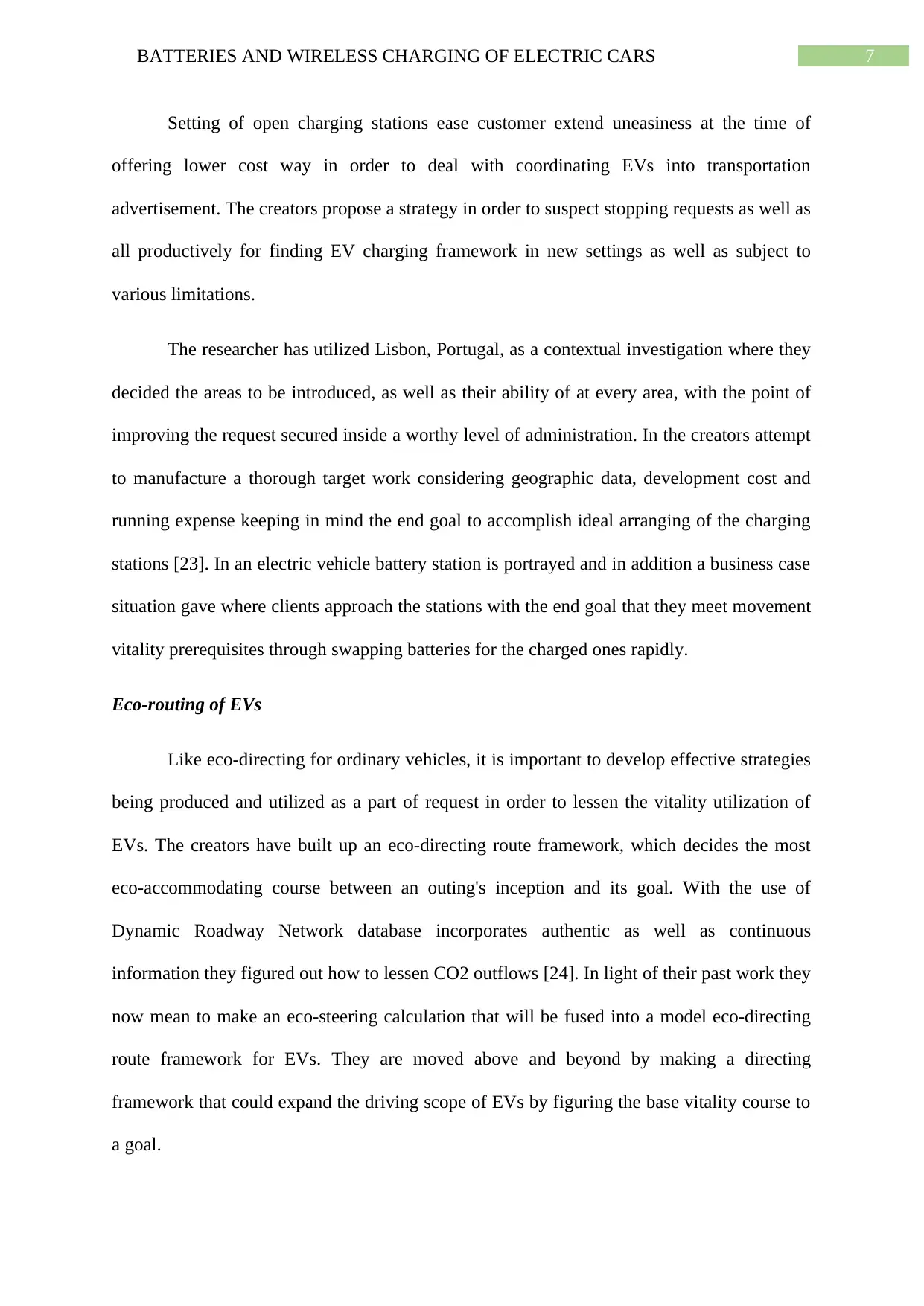
7BATTERIES AND WIRELESS CHARGING OF ELECTRIC CARS
Setting of open charging stations ease customer extend uneasiness at the time of
offering lower cost way in order to deal with coordinating EVs into transportation
advertisement. The creators propose a strategy in order to suspect stopping requests as well as
all productively for finding EV charging framework in new settings as well as subject to
various limitations.
The researcher has utilized Lisbon, Portugal, as a contextual investigation where they
decided the areas to be introduced, as well as their ability of at every area, with the point of
improving the request secured inside a worthy level of administration. In the creators attempt
to manufacture a thorough target work considering geographic data, development cost and
running expense keeping in mind the end goal to accomplish ideal arranging of the charging
stations [23]. In an electric vehicle battery station is portrayed and in addition a business case
situation gave where clients approach the stations with the end goal that they meet movement
vitality prerequisites through swapping batteries for the charged ones rapidly.
Eco-routing of EVs
Like eco-directing for ordinary vehicles, it is important to develop effective strategies
being produced and utilized as a part of request in order to lessen the vitality utilization of
EVs. The creators have built up an eco-directing route framework, which decides the most
eco-accommodating course between an outing's inception and its goal. With the use of
Dynamic Roadway Network database incorporates authentic as well as continuous
information they figured out how to lessen CO2 outflows [24]. In light of their past work they
now mean to make an eco-steering calculation that will be fused into a model eco-directing
route framework for EVs. They are moved above and beyond by making a directing
framework that could expand the driving scope of EVs by figuring the base vitality course to
a goal.
Setting of open charging stations ease customer extend uneasiness at the time of
offering lower cost way in order to deal with coordinating EVs into transportation
advertisement. The creators propose a strategy in order to suspect stopping requests as well as
all productively for finding EV charging framework in new settings as well as subject to
various limitations.
The researcher has utilized Lisbon, Portugal, as a contextual investigation where they
decided the areas to be introduced, as well as their ability of at every area, with the point of
improving the request secured inside a worthy level of administration. In the creators attempt
to manufacture a thorough target work considering geographic data, development cost and
running expense keeping in mind the end goal to accomplish ideal arranging of the charging
stations [23]. In an electric vehicle battery station is portrayed and in addition a business case
situation gave where clients approach the stations with the end goal that they meet movement
vitality prerequisites through swapping batteries for the charged ones rapidly.
Eco-routing of EVs
Like eco-directing for ordinary vehicles, it is important to develop effective strategies
being produced and utilized as a part of request in order to lessen the vitality utilization of
EVs. The creators have built up an eco-directing route framework, which decides the most
eco-accommodating course between an outing's inception and its goal. With the use of
Dynamic Roadway Network database incorporates authentic as well as continuous
information they figured out how to lessen CO2 outflows [24]. In light of their past work they
now mean to make an eco-steering calculation that will be fused into a model eco-directing
route framework for EVs. They are moved above and beyond by making a directing
framework that could expand the driving scope of EVs by figuring the base vitality course to
a goal.
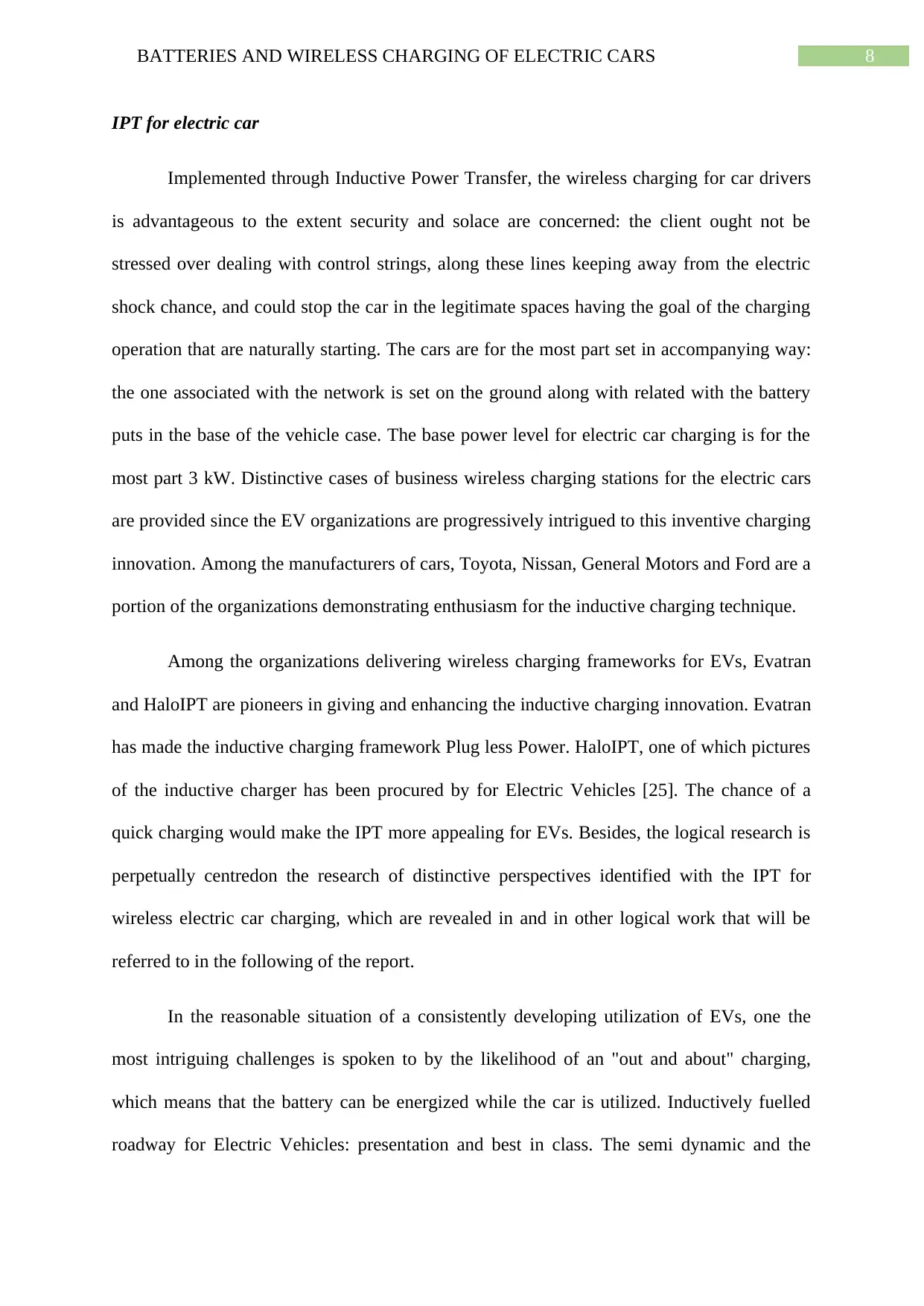
8BATTERIES AND WIRELESS CHARGING OF ELECTRIC CARS
IPT for electric car
Implemented through Inductive Power Transfer, the wireless charging for car drivers
is advantageous to the extent security and solace are concerned: the client ought not be
stressed over dealing with control strings, along these lines keeping away from the electric
shock chance, and could stop the car in the legitimate spaces having the goal of the charging
operation that are naturally starting. The cars are for the most part set in accompanying way:
the one associated with the network is set on the ground along with related with the battery
puts in the base of the vehicle case. The base power level for electric car charging is for the
most part 3 kW. Distinctive cases of business wireless charging stations for the electric cars
are provided since the EV organizations are progressively intrigued to this inventive charging
innovation. Among the manufacturers of cars, Toyota, Nissan, General Motors and Ford are a
portion of the organizations demonstrating enthusiasm for the inductive charging technique.
Among the organizations delivering wireless charging frameworks for EVs, Evatran
and HaloIPT are pioneers in giving and enhancing the inductive charging innovation. Evatran
has made the inductive charging framework Plug less Power. HaloIPT, one of which pictures
of the inductive charger has been procured by for Electric Vehicles [25]. The chance of a
quick charging would make the IPT more appealing for EVs. Besides, the logical research is
perpetually centredon the research of distinctive perspectives identified with the IPT for
wireless electric car charging, which are revealed in and in other logical work that will be
referred to in the following of the report.
In the reasonable situation of a consistently developing utilization of EVs, one the
most intriguing challenges is spoken to by the likelihood of an "out and about" charging,
which means that the battery can be energized while the car is utilized. Inductively fuelled
roadway for Electric Vehicles: presentation and best in class. The semi dynamic and the
IPT for electric car
Implemented through Inductive Power Transfer, the wireless charging for car drivers
is advantageous to the extent security and solace are concerned: the client ought not be
stressed over dealing with control strings, along these lines keeping away from the electric
shock chance, and could stop the car in the legitimate spaces having the goal of the charging
operation that are naturally starting. The cars are for the most part set in accompanying way:
the one associated with the network is set on the ground along with related with the battery
puts in the base of the vehicle case. The base power level for electric car charging is for the
most part 3 kW. Distinctive cases of business wireless charging stations for the electric cars
are provided since the EV organizations are progressively intrigued to this inventive charging
innovation. Among the manufacturers of cars, Toyota, Nissan, General Motors and Ford are a
portion of the organizations demonstrating enthusiasm for the inductive charging technique.
Among the organizations delivering wireless charging frameworks for EVs, Evatran
and HaloIPT are pioneers in giving and enhancing the inductive charging innovation. Evatran
has made the inductive charging framework Plug less Power. HaloIPT, one of which pictures
of the inductive charger has been procured by for Electric Vehicles [25]. The chance of a
quick charging would make the IPT more appealing for EVs. Besides, the logical research is
perpetually centredon the research of distinctive perspectives identified with the IPT for
wireless electric car charging, which are revealed in and in other logical work that will be
referred to in the following of the report.
In the reasonable situation of a consistently developing utilization of EVs, one the
most intriguing challenges is spoken to by the likelihood of an "out and about" charging,
which means that the battery can be energized while the car is utilized. Inductively fuelled
roadway for Electric Vehicles: presentation and best in class. The semi dynamic and the
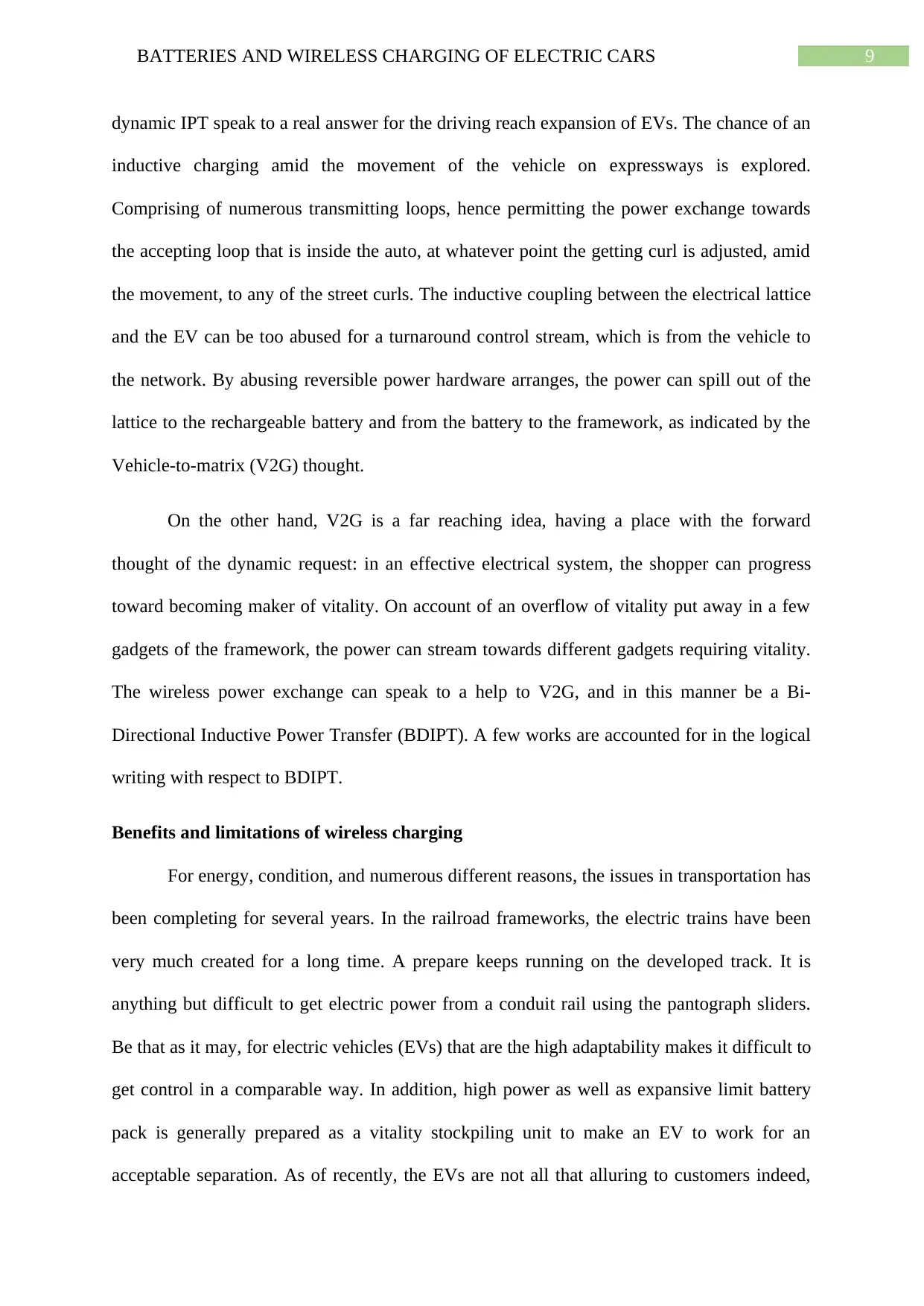
9BATTERIES AND WIRELESS CHARGING OF ELECTRIC CARS
dynamic IPT speak to a real answer for the driving reach expansion of EVs. The chance of an
inductive charging amid the movement of the vehicle on expressways is explored.
Comprising of numerous transmitting loops, hence permitting the power exchange towards
the accepting loop that is inside the auto, at whatever point the getting curl is adjusted, amid
the movement, to any of the street curls. The inductive coupling between the electrical lattice
and the EV can be too abused for a turnaround control stream, which is from the vehicle to
the network. By abusing reversible power hardware arranges, the power can spill out of the
lattice to the rechargeable battery and from the battery to the framework, as indicated by the
Vehicle-to-matrix (V2G) thought.
On the other hand, V2G is a far reaching idea, having a place with the forward
thought of the dynamic request: in an effective electrical system, the shopper can progress
toward becoming maker of vitality. On account of an overflow of vitality put away in a few
gadgets of the framework, the power can stream towards different gadgets requiring vitality.
The wireless power exchange can speak to a help to V2G, and in this manner be a Bi-
Directional Inductive Power Transfer (BDIPT). A few works are accounted for in the logical
writing with respect to BDIPT.
Benefits and limitations of wireless charging
For energy, condition, and numerous different reasons, the issues in transportation has
been completing for several years. In the railroad frameworks, the electric trains have been
very much created for a long time. A prepare keeps running on the developed track. It is
anything but difficult to get electric power from a conduit rail using the pantograph sliders.
Be that as it may, for electric vehicles (EVs) that are the high adaptability makes it difficult to
get control in a comparable way. In addition, high power as well as expansive limit battery
pack is generally prepared as a vitality stockpiling unit to make an EV to work for an
acceptable separation. As of recently, the EVs are not all that alluring to customers indeed,
dynamic IPT speak to a real answer for the driving reach expansion of EVs. The chance of an
inductive charging amid the movement of the vehicle on expressways is explored.
Comprising of numerous transmitting loops, hence permitting the power exchange towards
the accepting loop that is inside the auto, at whatever point the getting curl is adjusted, amid
the movement, to any of the street curls. The inductive coupling between the electrical lattice
and the EV can be too abused for a turnaround control stream, which is from the vehicle to
the network. By abusing reversible power hardware arranges, the power can spill out of the
lattice to the rechargeable battery and from the battery to the framework, as indicated by the
Vehicle-to-matrix (V2G) thought.
On the other hand, V2G is a far reaching idea, having a place with the forward
thought of the dynamic request: in an effective electrical system, the shopper can progress
toward becoming maker of vitality. On account of an overflow of vitality put away in a few
gadgets of the framework, the power can stream towards different gadgets requiring vitality.
The wireless power exchange can speak to a help to V2G, and in this manner be a Bi-
Directional Inductive Power Transfer (BDIPT). A few works are accounted for in the logical
writing with respect to BDIPT.
Benefits and limitations of wireless charging
For energy, condition, and numerous different reasons, the issues in transportation has
been completing for several years. In the railroad frameworks, the electric trains have been
very much created for a long time. A prepare keeps running on the developed track. It is
anything but difficult to get electric power from a conduit rail using the pantograph sliders.
Be that as it may, for electric vehicles (EVs) that are the high adaptability makes it difficult to
get control in a comparable way. In addition, high power as well as expansive limit battery
pack is generally prepared as a vitality stockpiling unit to make an EV to work for an
acceptable separation. As of recently, the EVs are not all that alluring to customers indeed,
Secure Best Marks with AI Grader
Need help grading? Try our AI Grader for instant feedback on your assignments.
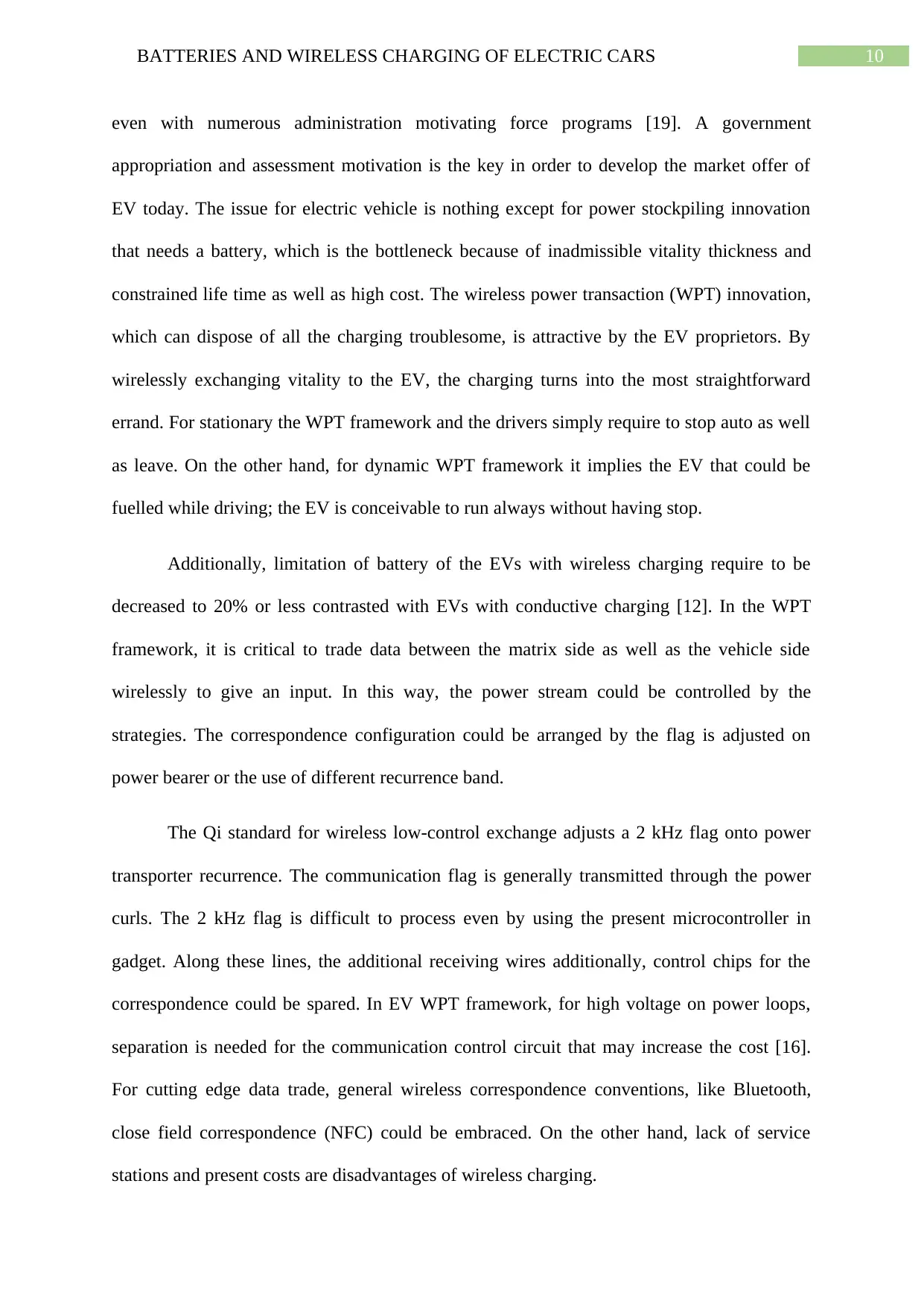
10BATTERIES AND WIRELESS CHARGING OF ELECTRIC CARS
even with numerous administration motivating force programs [19]. A government
appropriation and assessment motivation is the key in order to develop the market offer of
EV today. The issue for electric vehicle is nothing except for power stockpiling innovation
that needs a battery, which is the bottleneck because of inadmissible vitality thickness and
constrained life time as well as high cost. The wireless power transaction (WPT) innovation,
which can dispose of all the charging troublesome, is attractive by the EV proprietors. By
wirelessly exchanging vitality to the EV, the charging turns into the most straightforward
errand. For stationary the WPT framework and the drivers simply require to stop auto as well
as leave. On the other hand, for dynamic WPT framework it implies the EV that could be
fuelled while driving; the EV is conceivable to run always without having stop.
Additionally, limitation of battery of the EVs with wireless charging require to be
decreased to 20% or less contrasted with EVs with conductive charging [12]. In the WPT
framework, it is critical to trade data between the matrix side as well as the vehicle side
wirelessly to give an input. In this way, the power stream could be controlled by the
strategies. The correspondence configuration could be arranged by the flag is adjusted on
power bearer or the use of different recurrence band.
The Qi standard for wireless low-control exchange adjusts a 2 kHz flag onto power
transporter recurrence. The communication flag is generally transmitted through the power
curls. The 2 kHz flag is difficult to process even by using the present microcontroller in
gadget. Along these lines, the additional receiving wires additionally, control chips for the
correspondence could be spared. In EV WPT framework, for high voltage on power loops,
separation is needed for the communication control circuit that may increase the cost [16].
For cutting edge data trade, general wireless correspondence conventions, like Bluetooth,
close field correspondence (NFC) could be embraced. On the other hand, lack of service
stations and present costs are disadvantages of wireless charging.
even with numerous administration motivating force programs [19]. A government
appropriation and assessment motivation is the key in order to develop the market offer of
EV today. The issue for electric vehicle is nothing except for power stockpiling innovation
that needs a battery, which is the bottleneck because of inadmissible vitality thickness and
constrained life time as well as high cost. The wireless power transaction (WPT) innovation,
which can dispose of all the charging troublesome, is attractive by the EV proprietors. By
wirelessly exchanging vitality to the EV, the charging turns into the most straightforward
errand. For stationary the WPT framework and the drivers simply require to stop auto as well
as leave. On the other hand, for dynamic WPT framework it implies the EV that could be
fuelled while driving; the EV is conceivable to run always without having stop.
Additionally, limitation of battery of the EVs with wireless charging require to be
decreased to 20% or less contrasted with EVs with conductive charging [12]. In the WPT
framework, it is critical to trade data between the matrix side as well as the vehicle side
wirelessly to give an input. In this way, the power stream could be controlled by the
strategies. The correspondence configuration could be arranged by the flag is adjusted on
power bearer or the use of different recurrence band.
The Qi standard for wireless low-control exchange adjusts a 2 kHz flag onto power
transporter recurrence. The communication flag is generally transmitted through the power
curls. The 2 kHz flag is difficult to process even by using the present microcontroller in
gadget. Along these lines, the additional receiving wires additionally, control chips for the
correspondence could be spared. In EV WPT framework, for high voltage on power loops,
separation is needed for the communication control circuit that may increase the cost [16].
For cutting edge data trade, general wireless correspondence conventions, like Bluetooth,
close field correspondence (NFC) could be embraced. On the other hand, lack of service
stations and present costs are disadvantages of wireless charging.
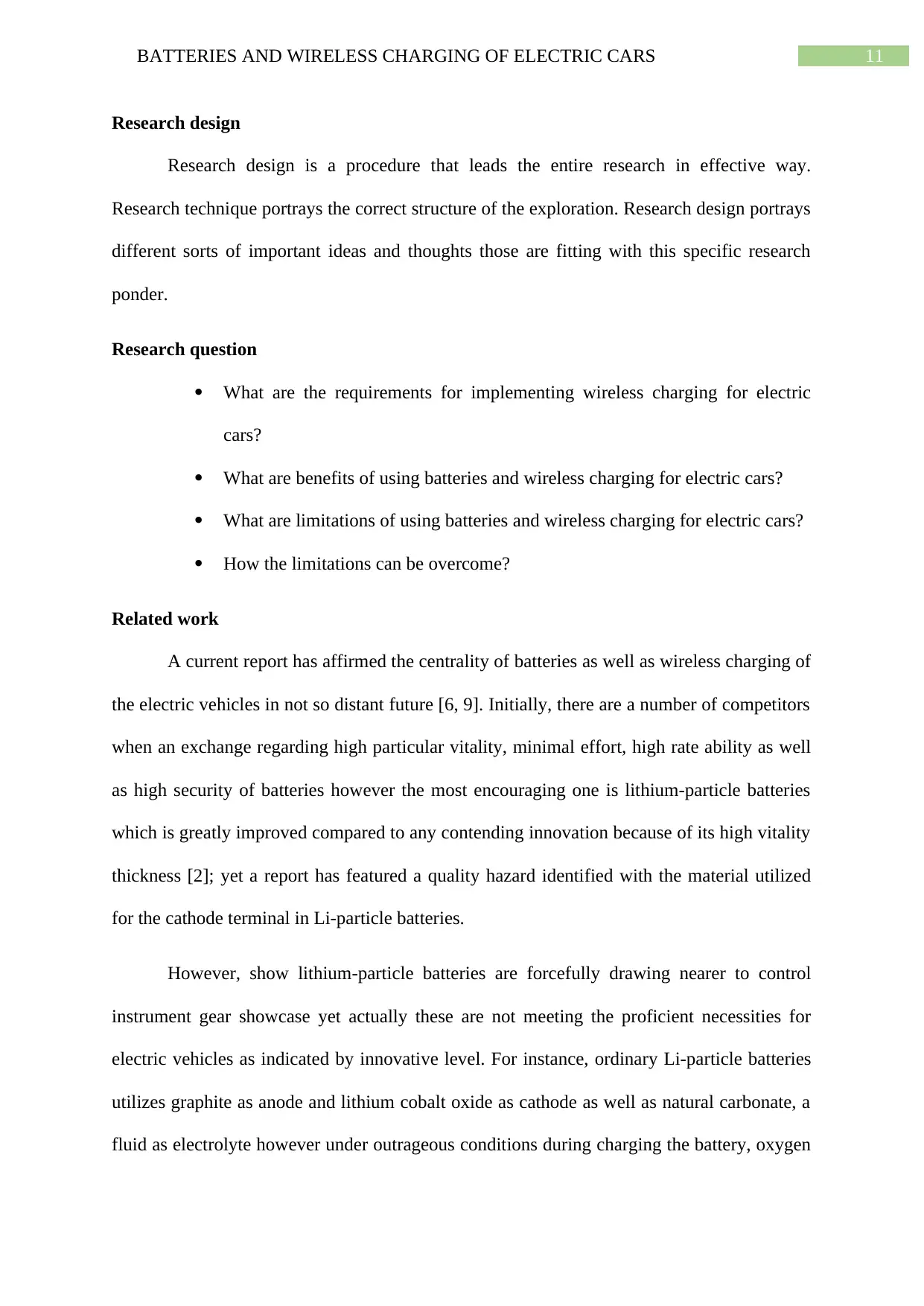
11BATTERIES AND WIRELESS CHARGING OF ELECTRIC CARS
Research design
Research design is a procedure that leads the entire research in effective way.
Research technique portrays the correct structure of the exploration. Research design portrays
different sorts of important ideas and thoughts those are fitting with this specific research
ponder.
Research question
What are the requirements for implementing wireless charging for electric
cars?
What are benefits of using batteries and wireless charging for electric cars?
What are limitations of using batteries and wireless charging for electric cars?
How the limitations can be overcome?
Related work
A current report has affirmed the centrality of batteries as well as wireless charging of
the electric vehicles in not so distant future [6, 9]. Initially, there are a number of competitors
when an exchange regarding high particular vitality, minimal effort, high rate ability as well
as high security of batteries however the most encouraging one is lithium-particle batteries
which is greatly improved compared to any contending innovation because of its high vitality
thickness [2]; yet a report has featured a quality hazard identified with the material utilized
for the cathode terminal in Li-particle batteries.
However, show lithium-particle batteries are forcefully drawing nearer to control
instrument gear showcase yet actually these are not meeting the proficient necessities for
electric vehicles as indicated by innovative level. For instance, ordinary Li-particle batteries
utilizes graphite as anode and lithium cobalt oxide as cathode as well as natural carbonate, a
fluid as electrolyte however under outrageous conditions during charging the battery, oxygen
Research design
Research design is a procedure that leads the entire research in effective way.
Research technique portrays the correct structure of the exploration. Research design portrays
different sorts of important ideas and thoughts those are fitting with this specific research
ponder.
Research question
What are the requirements for implementing wireless charging for electric
cars?
What are benefits of using batteries and wireless charging for electric cars?
What are limitations of using batteries and wireless charging for electric cars?
How the limitations can be overcome?
Related work
A current report has affirmed the centrality of batteries as well as wireless charging of
the electric vehicles in not so distant future [6, 9]. Initially, there are a number of competitors
when an exchange regarding high particular vitality, minimal effort, high rate ability as well
as high security of batteries however the most encouraging one is lithium-particle batteries
which is greatly improved compared to any contending innovation because of its high vitality
thickness [2]; yet a report has featured a quality hazard identified with the material utilized
for the cathode terminal in Li-particle batteries.
However, show lithium-particle batteries are forcefully drawing nearer to control
instrument gear showcase yet actually these are not meeting the proficient necessities for
electric vehicles as indicated by innovative level. For instance, ordinary Li-particle batteries
utilizes graphite as anode and lithium cobalt oxide as cathode as well as natural carbonate, a
fluid as electrolyte however under outrageous conditions during charging the battery, oxygen
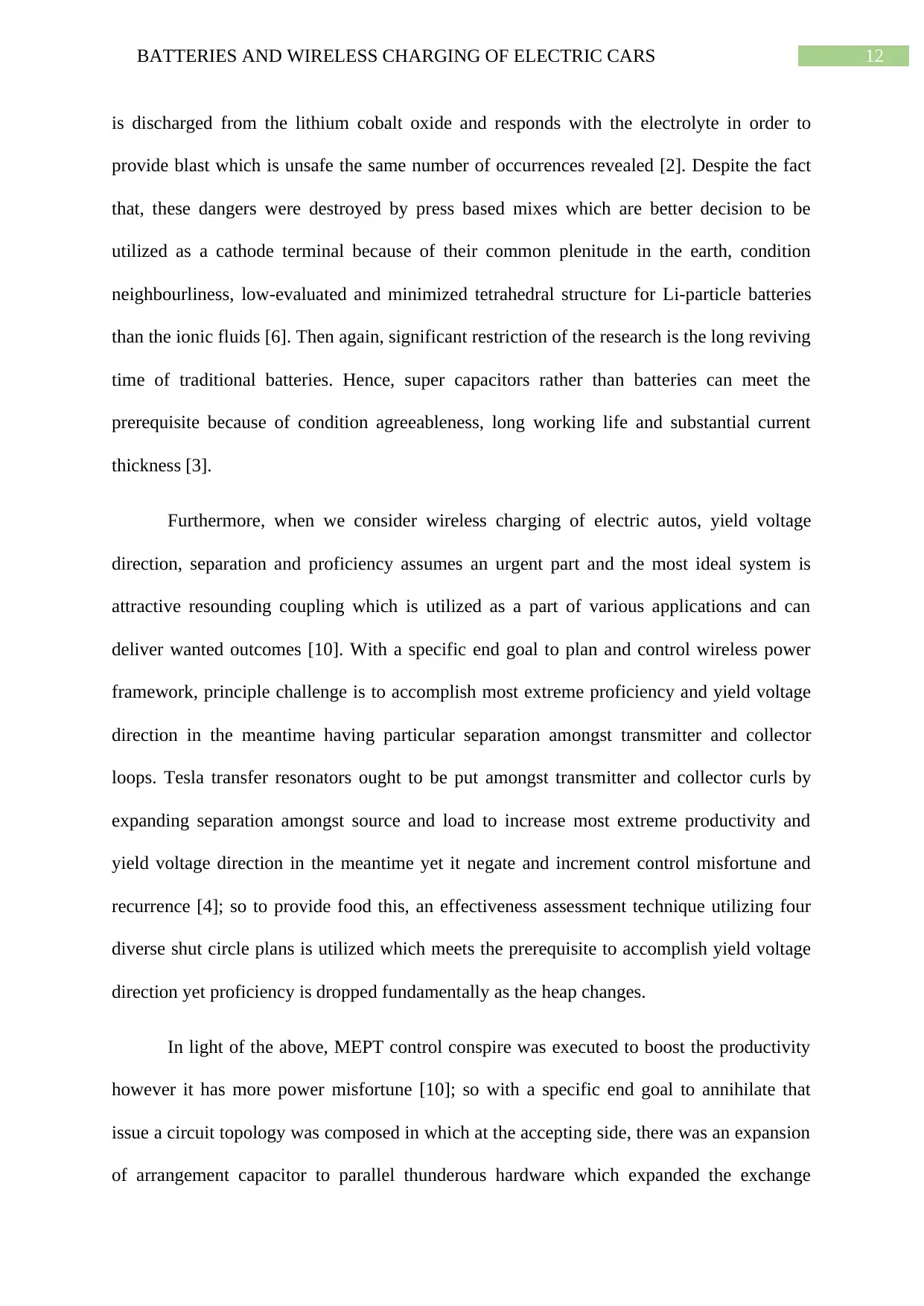
12BATTERIES AND WIRELESS CHARGING OF ELECTRIC CARS
is discharged from the lithium cobalt oxide and responds with the electrolyte in order to
provide blast which is unsafe the same number of occurrences revealed [2]. Despite the fact
that, these dangers were destroyed by press based mixes which are better decision to be
utilized as a cathode terminal because of their common plenitude in the earth, condition
neighbourliness, low-evaluated and minimized tetrahedral structure for Li-particle batteries
than the ionic fluids [6]. Then again, significant restriction of the research is the long reviving
time of traditional batteries. Hence, super capacitors rather than batteries can meet the
prerequisite because of condition agreeableness, long working life and substantial current
thickness [3].
Furthermore, when we consider wireless charging of electric autos, yield voltage
direction, separation and proficiency assumes an urgent part and the most ideal system is
attractive resounding coupling which is utilized as a part of various applications and can
deliver wanted outcomes [10]. With a specific end goal to plan and control wireless power
framework, principle challenge is to accomplish most extreme proficiency and yield voltage
direction in the meantime having particular separation amongst transmitter and collector
loops. Tesla transfer resonators ought to be put amongst transmitter and collector curls by
expanding separation amongst source and load to increase most extreme productivity and
yield voltage direction in the meantime yet it negate and increment control misfortune and
recurrence [4]; so to provide food this, an effectiveness assessment technique utilizing four
diverse shut circle plans is utilized which meets the prerequisite to accomplish yield voltage
direction yet proficiency is dropped fundamentally as the heap changes.
In light of the above, MEPT control conspire was executed to boost the productivity
however it has more power misfortune [10]; so with a specific end goal to annihilate that
issue a circuit topology was composed in which at the accepting side, there was an expansion
of arrangement capacitor to parallel thunderous hardware which expanded the exchange
is discharged from the lithium cobalt oxide and responds with the electrolyte in order to
provide blast which is unsafe the same number of occurrences revealed [2]. Despite the fact
that, these dangers were destroyed by press based mixes which are better decision to be
utilized as a cathode terminal because of their common plenitude in the earth, condition
neighbourliness, low-evaluated and minimized tetrahedral structure for Li-particle batteries
than the ionic fluids [6]. Then again, significant restriction of the research is the long reviving
time of traditional batteries. Hence, super capacitors rather than batteries can meet the
prerequisite because of condition agreeableness, long working life and substantial current
thickness [3].
Furthermore, when we consider wireless charging of electric autos, yield voltage
direction, separation and proficiency assumes an urgent part and the most ideal system is
attractive resounding coupling which is utilized as a part of various applications and can
deliver wanted outcomes [10]. With a specific end goal to plan and control wireless power
framework, principle challenge is to accomplish most extreme proficiency and yield voltage
direction in the meantime having particular separation amongst transmitter and collector
loops. Tesla transfer resonators ought to be put amongst transmitter and collector curls by
expanding separation amongst source and load to increase most extreme productivity and
yield voltage direction in the meantime yet it negate and increment control misfortune and
recurrence [4]; so to provide food this, an effectiveness assessment technique utilizing four
diverse shut circle plans is utilized which meets the prerequisite to accomplish yield voltage
direction yet proficiency is dropped fundamentally as the heap changes.
In light of the above, MEPT control conspire was executed to boost the productivity
however it has more power misfortune [10]; so with a specific end goal to annihilate that
issue a circuit topology was composed in which at the accepting side, there was an expansion
of arrangement capacitor to parallel thunderous hardware which expanded the exchange
Paraphrase This Document
Need a fresh take? Get an instant paraphrase of this document with our AI Paraphraser
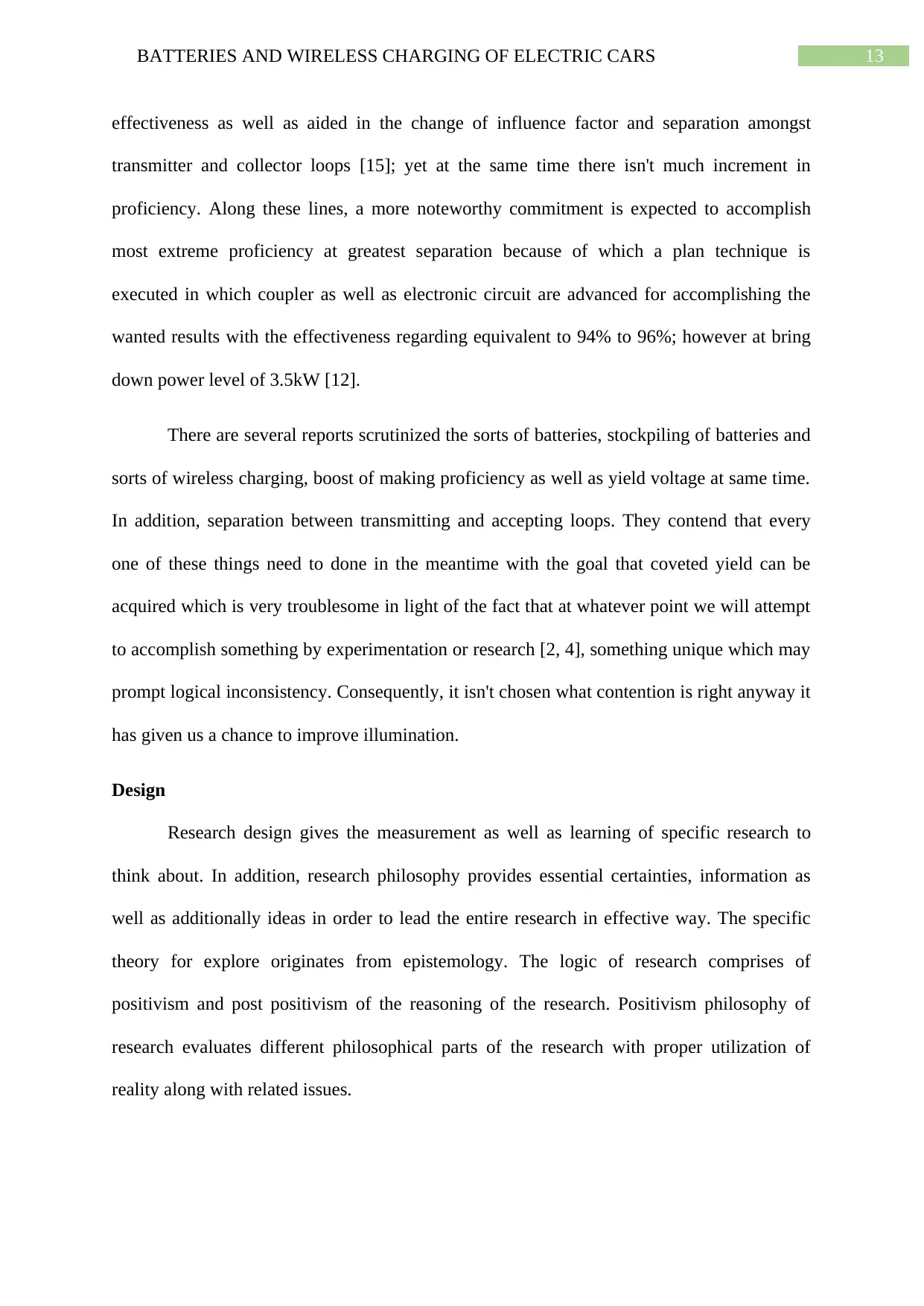
13BATTERIES AND WIRELESS CHARGING OF ELECTRIC CARS
effectiveness as well as aided in the change of influence factor and separation amongst
transmitter and collector loops [15]; yet at the same time there isn't much increment in
proficiency. Along these lines, a more noteworthy commitment is expected to accomplish
most extreme proficiency at greatest separation because of which a plan technique is
executed in which coupler as well as electronic circuit are advanced for accomplishing the
wanted results with the effectiveness regarding equivalent to 94% to 96%; however at bring
down power level of 3.5kW [12].
There are several reports scrutinized the sorts of batteries, stockpiling of batteries and
sorts of wireless charging, boost of making proficiency as well as yield voltage at same time.
In addition, separation between transmitting and accepting loops. They contend that every
one of these things need to done in the meantime with the goal that coveted yield can be
acquired which is very troublesome in light of the fact that at whatever point we will attempt
to accomplish something by experimentation or research [2, 4], something unique which may
prompt logical inconsistency. Consequently, it isn't chosen what contention is right anyway it
has given us a chance to improve illumination.
Design
Research design gives the measurement as well as learning of specific research to
think about. In addition, research philosophy provides essential certainties, information as
well as additionally ideas in order to lead the entire research in effective way. The specific
theory for explore originates from epistemology. The logic of research comprises of
positivism and post positivism of the reasoning of the research. Positivism philosophy of
research evaluates different philosophical parts of the research with proper utilization of
reality along with related issues.
effectiveness as well as aided in the change of influence factor and separation amongst
transmitter and collector loops [15]; yet at the same time there isn't much increment in
proficiency. Along these lines, a more noteworthy commitment is expected to accomplish
most extreme proficiency at greatest separation because of which a plan technique is
executed in which coupler as well as electronic circuit are advanced for accomplishing the
wanted results with the effectiveness regarding equivalent to 94% to 96%; however at bring
down power level of 3.5kW [12].
There are several reports scrutinized the sorts of batteries, stockpiling of batteries and
sorts of wireless charging, boost of making proficiency as well as yield voltage at same time.
In addition, separation between transmitting and accepting loops. They contend that every
one of these things need to done in the meantime with the goal that coveted yield can be
acquired which is very troublesome in light of the fact that at whatever point we will attempt
to accomplish something by experimentation or research [2, 4], something unique which may
prompt logical inconsistency. Consequently, it isn't chosen what contention is right anyway it
has given us a chance to improve illumination.
Design
Research design gives the measurement as well as learning of specific research to
think about. In addition, research philosophy provides essential certainties, information as
well as additionally ideas in order to lead the entire research in effective way. The specific
theory for explore originates from epistemology. The logic of research comprises of
positivism and post positivism of the reasoning of the research. Positivism philosophy of
research evaluates different philosophical parts of the research with proper utilization of
reality along with related issues.
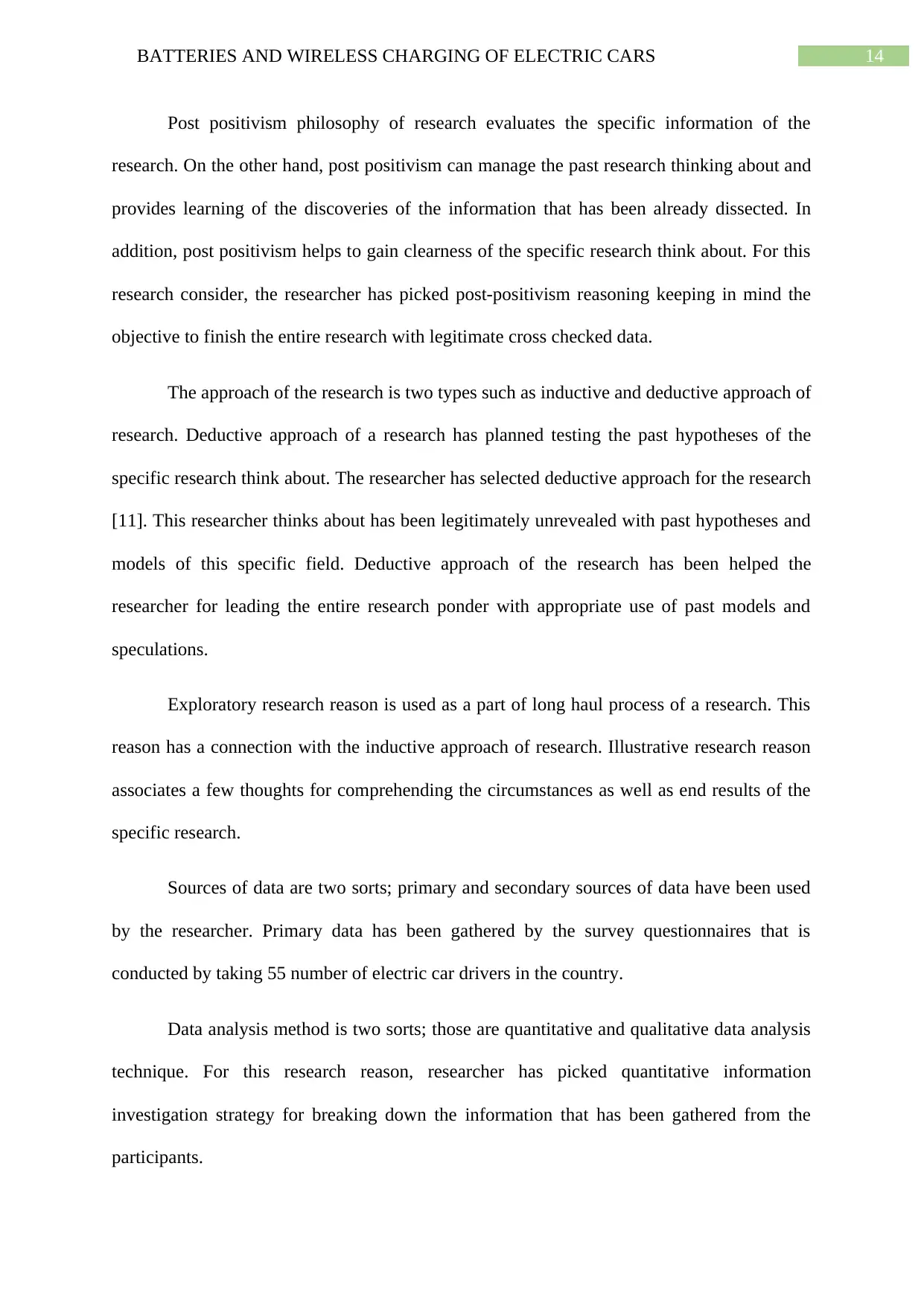
14BATTERIES AND WIRELESS CHARGING OF ELECTRIC CARS
Post positivism philosophy of research evaluates the specific information of the
research. On the other hand, post positivism can manage the past research thinking about and
provides learning of the discoveries of the information that has been already dissected. In
addition, post positivism helps to gain clearness of the specific research think about. For this
research consider, the researcher has picked post-positivism reasoning keeping in mind the
objective to finish the entire research with legitimate cross checked data.
The approach of the research is two types such as inductive and deductive approach of
research. Deductive approach of a research has planned testing the past hypotheses of the
specific research think about. The researcher has selected deductive approach for the research
[11]. This researcher thinks about has been legitimately unrevealed with past hypotheses and
models of this specific field. Deductive approach of the research has been helped the
researcher for leading the entire research ponder with appropriate use of past models and
speculations.
Exploratory research reason is used as a part of long haul process of a research. This
reason has a connection with the inductive approach of research. Illustrative research reason
associates a few thoughts for comprehending the circumstances as well as end results of the
specific research.
Sources of data are two sorts; primary and secondary sources of data have been used
by the researcher. Primary data has been gathered by the survey questionnaires that is
conducted by taking 55 number of electric car drivers in the country.
Data analysis method is two sorts; those are quantitative and qualitative data analysis
technique. For this research reason, researcher has picked quantitative information
investigation strategy for breaking down the information that has been gathered from the
participants.
Post positivism philosophy of research evaluates the specific information of the
research. On the other hand, post positivism can manage the past research thinking about and
provides learning of the discoveries of the information that has been already dissected. In
addition, post positivism helps to gain clearness of the specific research think about. For this
research consider, the researcher has picked post-positivism reasoning keeping in mind the
objective to finish the entire research with legitimate cross checked data.
The approach of the research is two types such as inductive and deductive approach of
research. Deductive approach of a research has planned testing the past hypotheses of the
specific research think about. The researcher has selected deductive approach for the research
[11]. This researcher thinks about has been legitimately unrevealed with past hypotheses and
models of this specific field. Deductive approach of the research has been helped the
researcher for leading the entire research ponder with appropriate use of past models and
speculations.
Exploratory research reason is used as a part of long haul process of a research. This
reason has a connection with the inductive approach of research. Illustrative research reason
associates a few thoughts for comprehending the circumstances as well as end results of the
specific research.
Sources of data are two sorts; primary and secondary sources of data have been used
by the researcher. Primary data has been gathered by the survey questionnaires that is
conducted by taking 55 number of electric car drivers in the country.
Data analysis method is two sorts; those are quantitative and qualitative data analysis
technique. For this research reason, researcher has picked quantitative information
investigation strategy for breaking down the information that has been gathered from the
participants.

15BATTERIES AND WIRELESS CHARGING OF ELECTRIC CARS
Design questions
How the data will be collected?
Will there be any accessibility and ethical issues lied?
What are the key ethical issues related with the research that will enforce the
participants to take part in survey?
Design questions
How the data will be collected?
Will there be any accessibility and ethical issues lied?
What are the key ethical issues related with the research that will enforce the
participants to take part in survey?
Secure Best Marks with AI Grader
Need help grading? Try our AI Grader for instant feedback on your assignments.
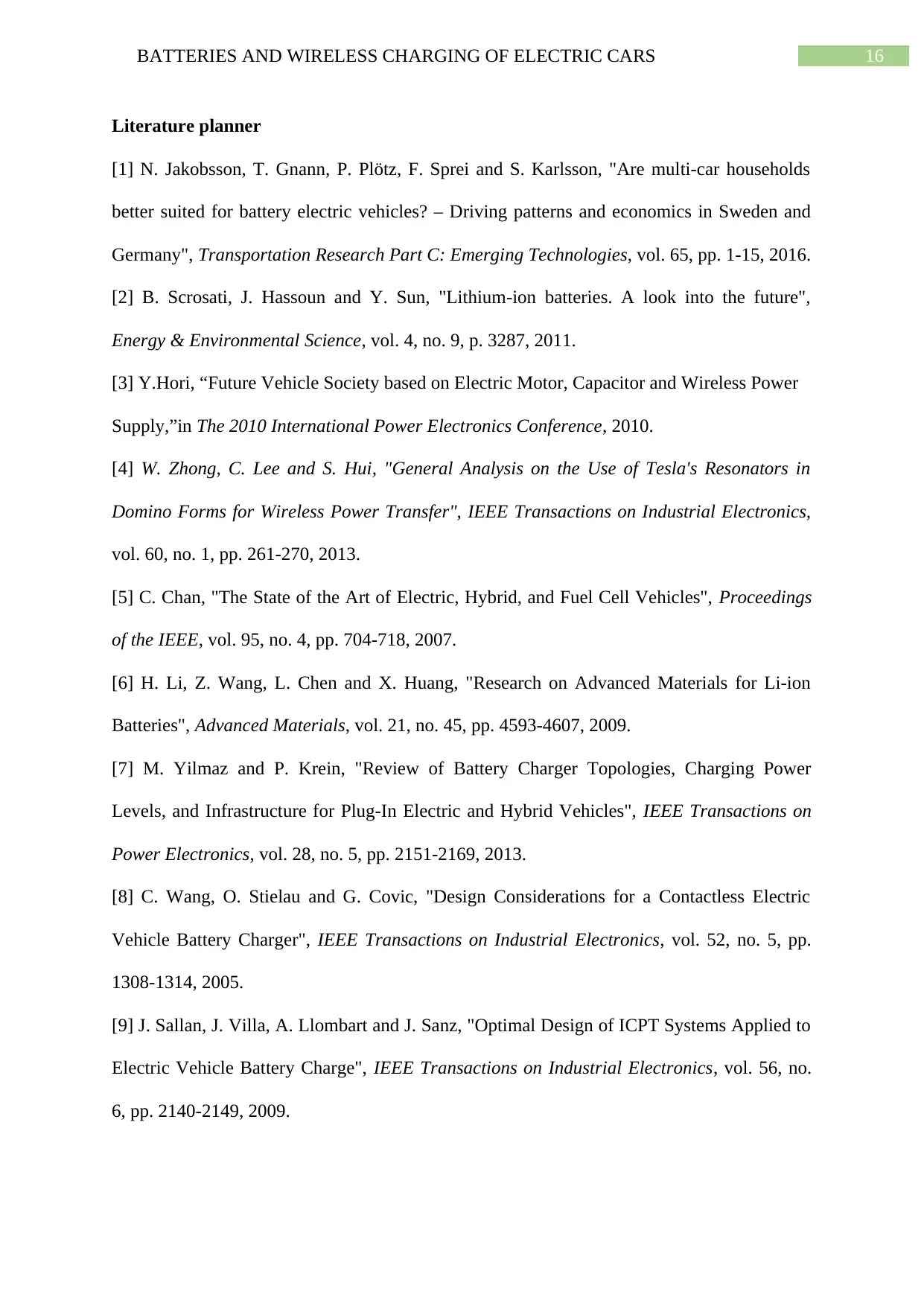
16BATTERIES AND WIRELESS CHARGING OF ELECTRIC CARS
Literature planner
[1] N. Jakobsson, T. Gnann, P. Plötz, F. Sprei and S. Karlsson, "Are multi-car households
better suited for battery electric vehicles? – Driving patterns and economics in Sweden and
Germany", Transportation Research Part C: Emerging Technologies, vol. 65, pp. 1-15, 2016.
[2] B. Scrosati, J. Hassoun and Y. Sun, "Lithium-ion batteries. A look into the future",
Energy & Environmental Science, vol. 4, no. 9, p. 3287, 2011.
[3] Y.Hori, “Future Vehicle Society based on Electric Motor, Capacitor and Wireless Power
Supply,”in The 2010 International Power Electronics Conference, 2010.
[4] W. Zhong, C. Lee and S. Hui, "General Analysis on the Use of Tesla's Resonators in
Domino Forms for Wireless Power Transfer", IEEE Transactions on Industrial Electronics,
vol. 60, no. 1, pp. 261-270, 2013.
[5] C. Chan, "The State of the Art of Electric, Hybrid, and Fuel Cell Vehicles", Proceedings
of the IEEE, vol. 95, no. 4, pp. 704-718, 2007.
[6] H. Li, Z. Wang, L. Chen and X. Huang, "Research on Advanced Materials for Li-ion
Batteries", Advanced Materials, vol. 21, no. 45, pp. 4593-4607, 2009.
[7] M. Yilmaz and P. Krein, "Review of Battery Charger Topologies, Charging Power
Levels, and Infrastructure for Plug-In Electric and Hybrid Vehicles", IEEE Transactions on
Power Electronics, vol. 28, no. 5, pp. 2151-2169, 2013.
[8] C. Wang, O. Stielau and G. Covic, "Design Considerations for a Contactless Electric
Vehicle Battery Charger", IEEE Transactions on Industrial Electronics, vol. 52, no. 5, pp.
1308-1314, 2005.
[9] J. Sallan, J. Villa, A. Llombart and J. Sanz, "Optimal Design of ICPT Systems Applied to
Electric Vehicle Battery Charge", IEEE Transactions on Industrial Electronics, vol. 56, no.
6, pp. 2140-2149, 2009.
Literature planner
[1] N. Jakobsson, T. Gnann, P. Plötz, F. Sprei and S. Karlsson, "Are multi-car households
better suited for battery electric vehicles? – Driving patterns and economics in Sweden and
Germany", Transportation Research Part C: Emerging Technologies, vol. 65, pp. 1-15, 2016.
[2] B. Scrosati, J. Hassoun and Y. Sun, "Lithium-ion batteries. A look into the future",
Energy & Environmental Science, vol. 4, no. 9, p. 3287, 2011.
[3] Y.Hori, “Future Vehicle Society based on Electric Motor, Capacitor and Wireless Power
Supply,”in The 2010 International Power Electronics Conference, 2010.
[4] W. Zhong, C. Lee and S. Hui, "General Analysis on the Use of Tesla's Resonators in
Domino Forms for Wireless Power Transfer", IEEE Transactions on Industrial Electronics,
vol. 60, no. 1, pp. 261-270, 2013.
[5] C. Chan, "The State of the Art of Electric, Hybrid, and Fuel Cell Vehicles", Proceedings
of the IEEE, vol. 95, no. 4, pp. 704-718, 2007.
[6] H. Li, Z. Wang, L. Chen and X. Huang, "Research on Advanced Materials for Li-ion
Batteries", Advanced Materials, vol. 21, no. 45, pp. 4593-4607, 2009.
[7] M. Yilmaz and P. Krein, "Review of Battery Charger Topologies, Charging Power
Levels, and Infrastructure for Plug-In Electric and Hybrid Vehicles", IEEE Transactions on
Power Electronics, vol. 28, no. 5, pp. 2151-2169, 2013.
[8] C. Wang, O. Stielau and G. Covic, "Design Considerations for a Contactless Electric
Vehicle Battery Charger", IEEE Transactions on Industrial Electronics, vol. 52, no. 5, pp.
1308-1314, 2005.
[9] J. Sallan, J. Villa, A. Llombart and J. Sanz, "Optimal Design of ICPT Systems Applied to
Electric Vehicle Battery Charge", IEEE Transactions on Industrial Electronics, vol. 56, no.
6, pp. 2140-2149, 2009.
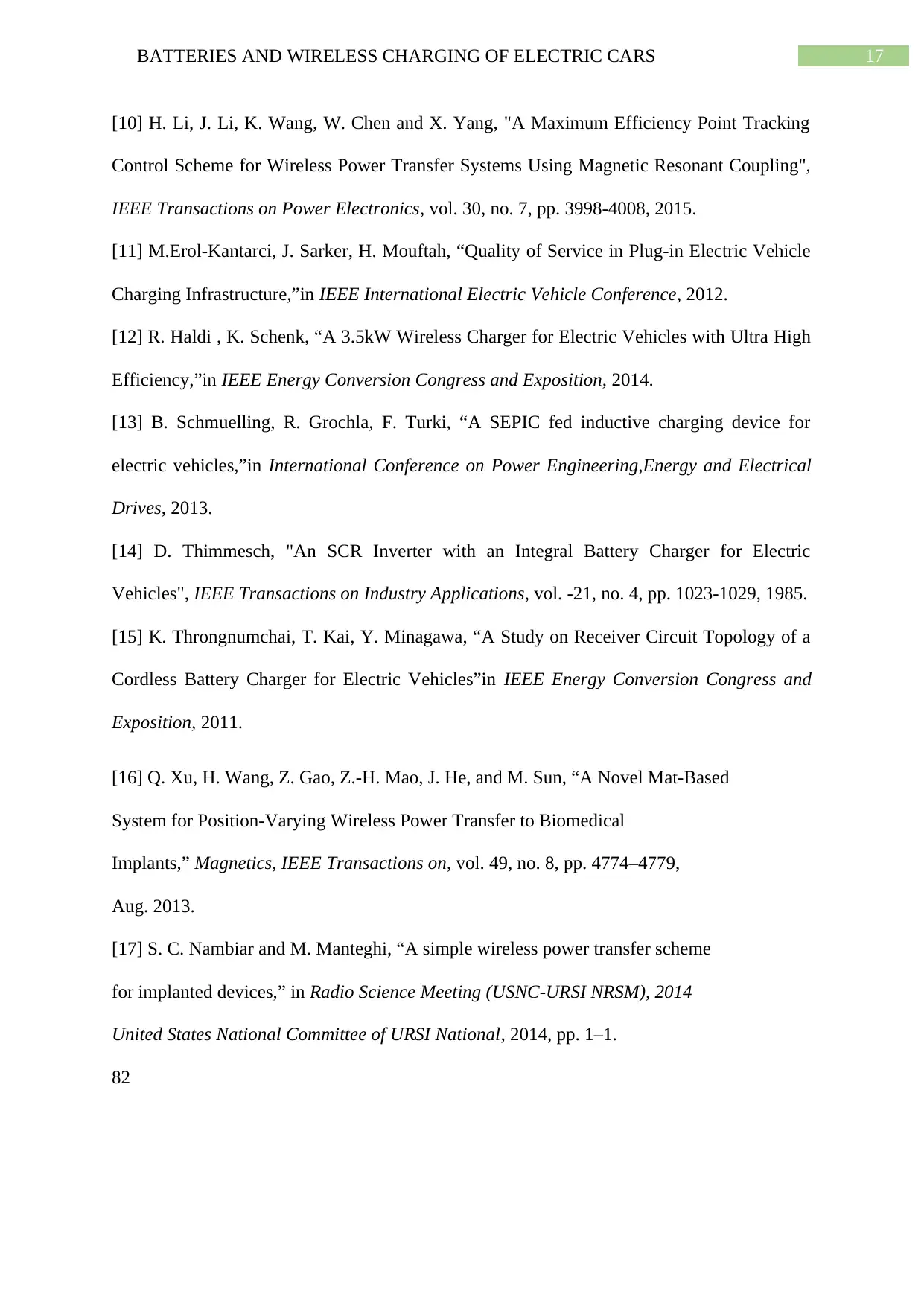
17BATTERIES AND WIRELESS CHARGING OF ELECTRIC CARS
[10] H. Li, J. Li, K. Wang, W. Chen and X. Yang, "A Maximum Efficiency Point Tracking
Control Scheme for Wireless Power Transfer Systems Using Magnetic Resonant Coupling",
IEEE Transactions on Power Electronics, vol. 30, no. 7, pp. 3998-4008, 2015.
[11] M.Erol-Kantarci, J. Sarker, H. Mouftah, “Quality of Service in Plug-in Electric Vehicle
Charging Infrastructure,”in IEEE International Electric Vehicle Conference, 2012.
[12] R. Haldi , K. Schenk, “A 3.5kW Wireless Charger for Electric Vehicles with Ultra High
Efficiency,”in IEEE Energy Conversion Congress and Exposition, 2014.
[13] B. Schmuelling, R. Grochla, F. Turki, “A SEPIC fed inductive charging device for
electric vehicles,”in International Conference on Power Engineering,Energy and Electrical
Drives, 2013.
[14] D. Thimmesch, "An SCR Inverter with an Integral Battery Charger for Electric
Vehicles", IEEE Transactions on Industry Applications, vol. -21, no. 4, pp. 1023-1029, 1985.
[15] K. Throngnumchai, T. Kai, Y. Minagawa, “A Study on Receiver Circuit Topology of a
Cordless Battery Charger for Electric Vehicles”in IEEE Energy Conversion Congress and
Exposition, 2011.
[16] Q. Xu, H. Wang, Z. Gao, Z.-H. Mao, J. He, and M. Sun, “A Novel Mat-Based
System for Position-Varying Wireless Power Transfer to Biomedical
Implants,” Magnetics, IEEE Transactions on, vol. 49, no. 8, pp. 4774–4779,
Aug. 2013.
[17] S. C. Nambiar and M. Manteghi, “A simple wireless power transfer scheme
for implanted devices,” in Radio Science Meeting (USNC-URSI NRSM), 2014
United States National Committee of URSI National, 2014, pp. 1–1.
82
[10] H. Li, J. Li, K. Wang, W. Chen and X. Yang, "A Maximum Efficiency Point Tracking
Control Scheme for Wireless Power Transfer Systems Using Magnetic Resonant Coupling",
IEEE Transactions on Power Electronics, vol. 30, no. 7, pp. 3998-4008, 2015.
[11] M.Erol-Kantarci, J. Sarker, H. Mouftah, “Quality of Service in Plug-in Electric Vehicle
Charging Infrastructure,”in IEEE International Electric Vehicle Conference, 2012.
[12] R. Haldi , K. Schenk, “A 3.5kW Wireless Charger for Electric Vehicles with Ultra High
Efficiency,”in IEEE Energy Conversion Congress and Exposition, 2014.
[13] B. Schmuelling, R. Grochla, F. Turki, “A SEPIC fed inductive charging device for
electric vehicles,”in International Conference on Power Engineering,Energy and Electrical
Drives, 2013.
[14] D. Thimmesch, "An SCR Inverter with an Integral Battery Charger for Electric
Vehicles", IEEE Transactions on Industry Applications, vol. -21, no. 4, pp. 1023-1029, 1985.
[15] K. Throngnumchai, T. Kai, Y. Minagawa, “A Study on Receiver Circuit Topology of a
Cordless Battery Charger for Electric Vehicles”in IEEE Energy Conversion Congress and
Exposition, 2011.
[16] Q. Xu, H. Wang, Z. Gao, Z.-H. Mao, J. He, and M. Sun, “A Novel Mat-Based
System for Position-Varying Wireless Power Transfer to Biomedical
Implants,” Magnetics, IEEE Transactions on, vol. 49, no. 8, pp. 4774–4779,
Aug. 2013.
[17] S. C. Nambiar and M. Manteghi, “A simple wireless power transfer scheme
for implanted devices,” in Radio Science Meeting (USNC-URSI NRSM), 2014
United States National Committee of URSI National, 2014, pp. 1–1.
82
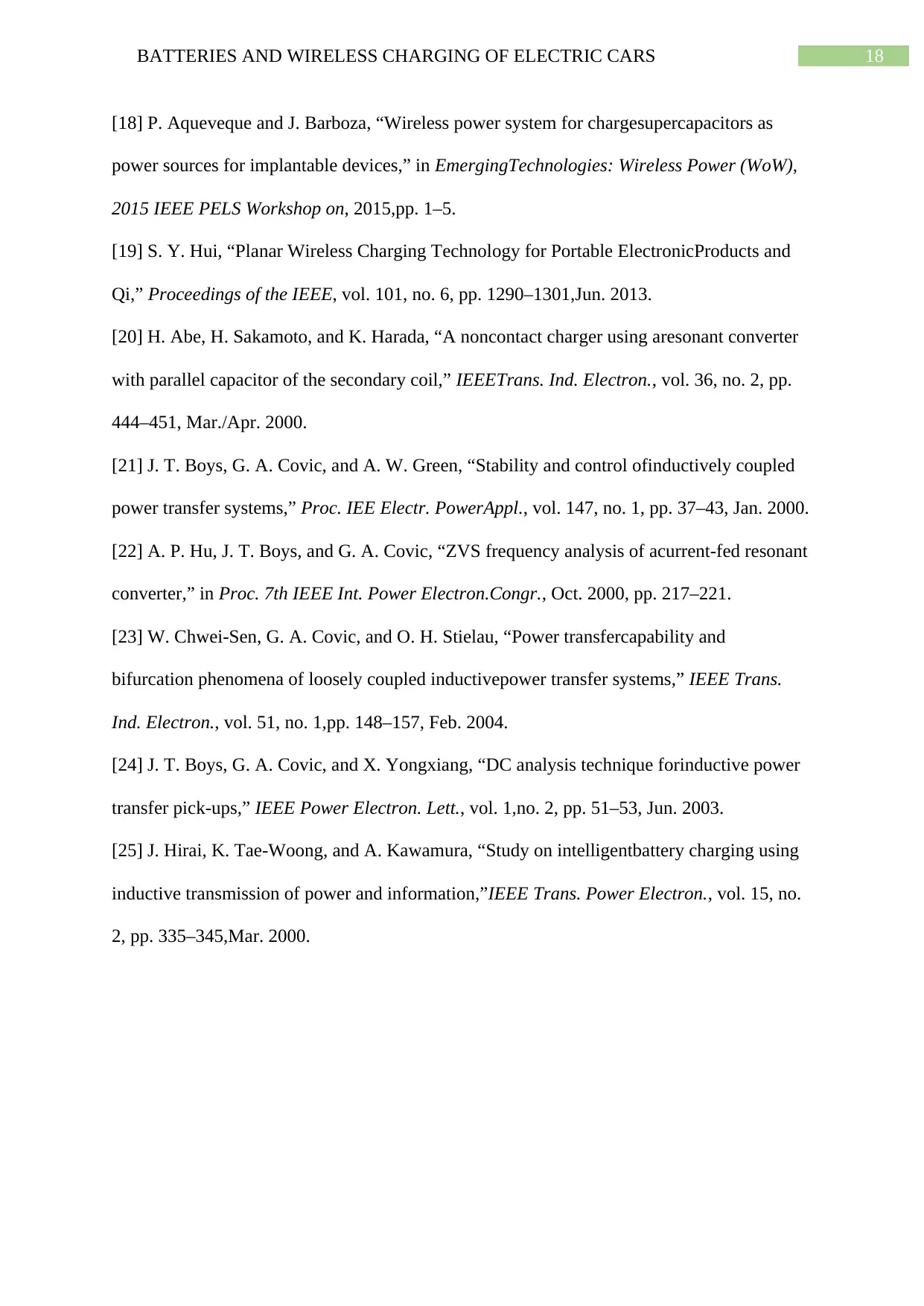
18BATTERIES AND WIRELESS CHARGING OF ELECTRIC CARS
[18] P. Aqueveque and J. Barboza, “Wireless power system for chargesupercapacitors as
power sources for implantable devices,” in EmergingTechnologies: Wireless Power (WoW),
2015 IEEE PELS Workshop on, 2015,pp. 1–5.
[19] S. Y. Hui, “Planar Wireless Charging Technology for Portable ElectronicProducts and
Qi,” Proceedings of the IEEE, vol. 101, no. 6, pp. 1290–1301,Jun. 2013.
[20] H. Abe, H. Sakamoto, and K. Harada, “A noncontact charger using aresonant converter
with parallel capacitor of the secondary coil,” IEEETrans. Ind. Electron., vol. 36, no. 2, pp.
444–451, Mar./Apr. 2000.
[21] J. T. Boys, G. A. Covic, and A. W. Green, “Stability and control ofinductively coupled
power transfer systems,” Proc. IEE Electr. PowerAppl., vol. 147, no. 1, pp. 37–43, Jan. 2000.
[22] A. P. Hu, J. T. Boys, and G. A. Covic, “ZVS frequency analysis of acurrent-fed resonant
converter,” in Proc. 7th IEEE Int. Power Electron.Congr., Oct. 2000, pp. 217–221.
[23] W. Chwei-Sen, G. A. Covic, and O. H. Stielau, “Power transfercapability and
bifurcation phenomena of loosely coupled inductivepower transfer systems,” IEEE Trans.
Ind. Electron., vol. 51, no. 1,pp. 148–157, Feb. 2004.
[24] J. T. Boys, G. A. Covic, and X. Yongxiang, “DC analysis technique forinductive power
transfer pick-ups,” IEEE Power Electron. Lett., vol. 1,no. 2, pp. 51–53, Jun. 2003.
[25] J. Hirai, K. Tae-Woong, and A. Kawamura, “Study on intelligentbattery charging using
inductive transmission of power and information,”IEEE Trans. Power Electron., vol. 15, no.
2, pp. 335–345,Mar. 2000.
[18] P. Aqueveque and J. Barboza, “Wireless power system for chargesupercapacitors as
power sources for implantable devices,” in EmergingTechnologies: Wireless Power (WoW),
2015 IEEE PELS Workshop on, 2015,pp. 1–5.
[19] S. Y. Hui, “Planar Wireless Charging Technology for Portable ElectronicProducts and
Qi,” Proceedings of the IEEE, vol. 101, no. 6, pp. 1290–1301,Jun. 2013.
[20] H. Abe, H. Sakamoto, and K. Harada, “A noncontact charger using aresonant converter
with parallel capacitor of the secondary coil,” IEEETrans. Ind. Electron., vol. 36, no. 2, pp.
444–451, Mar./Apr. 2000.
[21] J. T. Boys, G. A. Covic, and A. W. Green, “Stability and control ofinductively coupled
power transfer systems,” Proc. IEE Electr. PowerAppl., vol. 147, no. 1, pp. 37–43, Jan. 2000.
[22] A. P. Hu, J. T. Boys, and G. A. Covic, “ZVS frequency analysis of acurrent-fed resonant
converter,” in Proc. 7th IEEE Int. Power Electron.Congr., Oct. 2000, pp. 217–221.
[23] W. Chwei-Sen, G. A. Covic, and O. H. Stielau, “Power transfercapability and
bifurcation phenomena of loosely coupled inductivepower transfer systems,” IEEE Trans.
Ind. Electron., vol. 51, no. 1,pp. 148–157, Feb. 2004.
[24] J. T. Boys, G. A. Covic, and X. Yongxiang, “DC analysis technique forinductive power
transfer pick-ups,” IEEE Power Electron. Lett., vol. 1,no. 2, pp. 51–53, Jun. 2003.
[25] J. Hirai, K. Tae-Woong, and A. Kawamura, “Study on intelligentbattery charging using
inductive transmission of power and information,”IEEE Trans. Power Electron., vol. 15, no.
2, pp. 335–345,Mar. 2000.
Paraphrase This Document
Need a fresh take? Get an instant paraphrase of this document with our AI Paraphraser
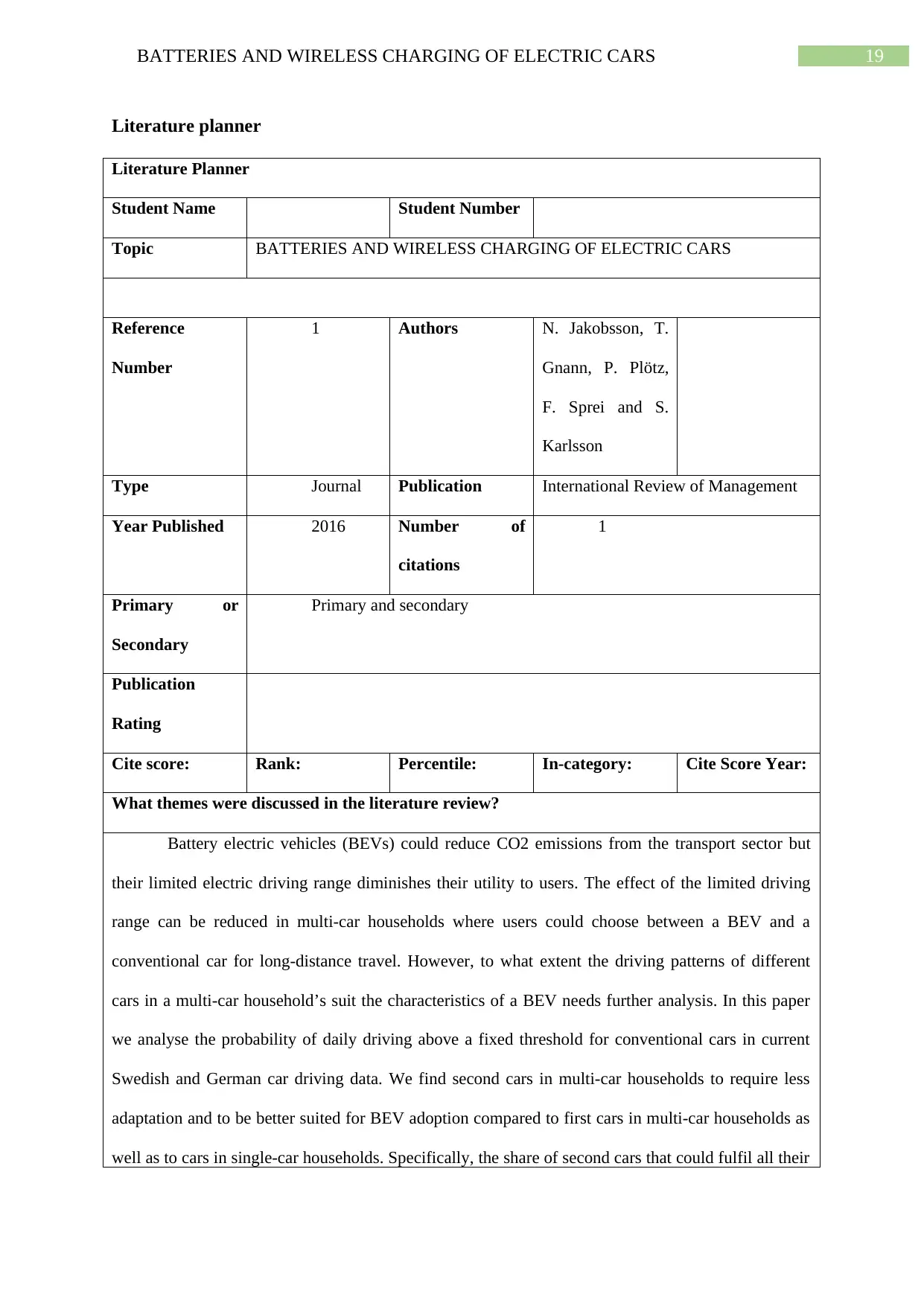
19BATTERIES AND WIRELESS CHARGING OF ELECTRIC CARS
Literature planner
Literature Planner
Student Name Student Number
Topic BATTERIES AND WIRELESS CHARGING OF ELECTRIC CARS
Reference
Number
1 Authors N. Jakobsson, T.
Gnann, P. Plötz,
F. Sprei and S.
Karlsson
Type Journal Publication International Review of Management
Year Published 2016 Number of
citations
1
Primary or
Secondary
Primary and secondary
Publication
Rating
Cite score: Rank: Percentile: In-category: Cite Score Year:
What themes were discussed in the literature review?
Battery electric vehicles (BEVs) could reduce CO2 emissions from the transport sector but
their limited electric driving range diminishes their utility to users. The effect of the limited driving
range can be reduced in multi-car households where users could choose between a BEV and a
conventional car for long-distance travel. However, to what extent the driving patterns of different
cars in a multi-car household’s suit the characteristics of a BEV needs further analysis. In this paper
we analyse the probability of daily driving above a fixed threshold for conventional cars in current
Swedish and German car driving data. We find second cars in multi-car households to require less
adaptation and to be better suited for BEV adoption compared to first cars in multi-car households as
well as to cars in single-car households. Specifically, the share of second cars that could fulfil all their
Literature planner
Literature Planner
Student Name Student Number
Topic BATTERIES AND WIRELESS CHARGING OF ELECTRIC CARS
Reference
Number
1 Authors N. Jakobsson, T.
Gnann, P. Plötz,
F. Sprei and S.
Karlsson
Type Journal Publication International Review of Management
Year Published 2016 Number of
citations
1
Primary or
Secondary
Primary and secondary
Publication
Rating
Cite score: Rank: Percentile: In-category: Cite Score Year:
What themes were discussed in the literature review?
Battery electric vehicles (BEVs) could reduce CO2 emissions from the transport sector but
their limited electric driving range diminishes their utility to users. The effect of the limited driving
range can be reduced in multi-car households where users could choose between a BEV and a
conventional car for long-distance travel. However, to what extent the driving patterns of different
cars in a multi-car household’s suit the characteristics of a BEV needs further analysis. In this paper
we analyse the probability of daily driving above a fixed threshold for conventional cars in current
Swedish and German car driving data. We find second cars in multi-car households to require less
adaptation and to be better suited for BEV adoption compared to first cars in multi-car households as
well as to cars in single-car households. Specifically, the share of second cars that could fulfil all their
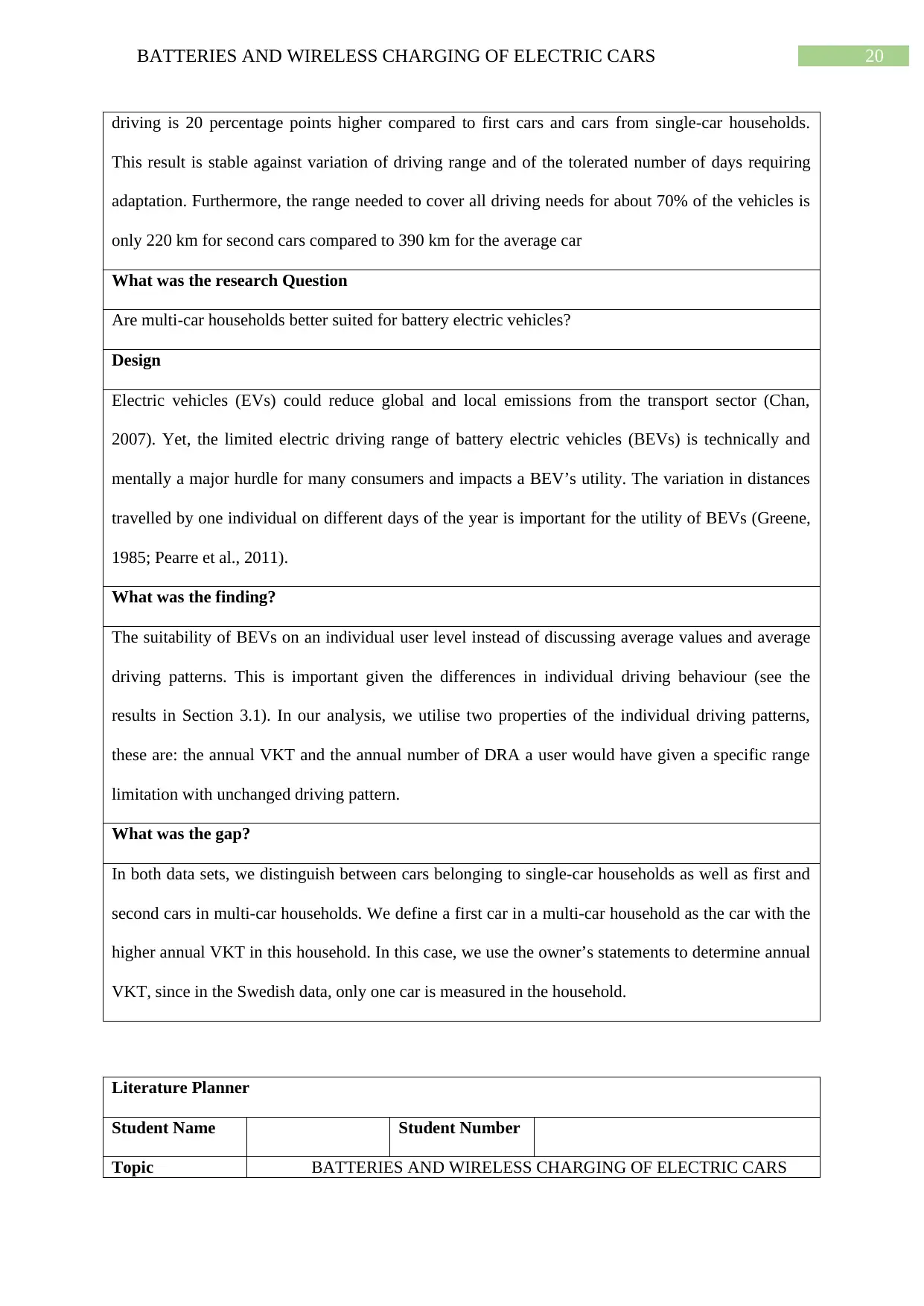
20BATTERIES AND WIRELESS CHARGING OF ELECTRIC CARS
driving is 20 percentage points higher compared to first cars and cars from single-car households.
This result is stable against variation of driving range and of the tolerated number of days requiring
adaptation. Furthermore, the range needed to cover all driving needs for about 70% of the vehicles is
only 220 km for second cars compared to 390 km for the average car
What was the research Question
Are multi-car households better suited for battery electric vehicles?
Design
Electric vehicles (EVs) could reduce global and local emissions from the transport sector (Chan,
2007). Yet, the limited electric driving range of battery electric vehicles (BEVs) is technically and
mentally a major hurdle for many consumers and impacts a BEV’s utility. The variation in distances
travelled by one individual on different days of the year is important for the utility of BEVs (Greene,
1985; Pearre et al., 2011).
What was the finding?
The suitability of BEVs on an individual user level instead of discussing average values and average
driving patterns. This is important given the differences in individual driving behaviour (see the
results in Section 3.1). In our analysis, we utilise two properties of the individual driving patterns,
these are: the annual VKT and the annual number of DRA a user would have given a specific range
limitation with unchanged driving pattern.
What was the gap?
In both data sets, we distinguish between cars belonging to single-car households as well as first and
second cars in multi-car households. We define a first car in a multi-car household as the car with the
higher annual VKT in this household. In this case, we use the owner’s statements to determine annual
VKT, since in the Swedish data, only one car is measured in the household.
Literature Planner
Student Name Student Number
Topic BATTERIES AND WIRELESS CHARGING OF ELECTRIC CARS
driving is 20 percentage points higher compared to first cars and cars from single-car households.
This result is stable against variation of driving range and of the tolerated number of days requiring
adaptation. Furthermore, the range needed to cover all driving needs for about 70% of the vehicles is
only 220 km for second cars compared to 390 km for the average car
What was the research Question
Are multi-car households better suited for battery electric vehicles?
Design
Electric vehicles (EVs) could reduce global and local emissions from the transport sector (Chan,
2007). Yet, the limited electric driving range of battery electric vehicles (BEVs) is technically and
mentally a major hurdle for many consumers and impacts a BEV’s utility. The variation in distances
travelled by one individual on different days of the year is important for the utility of BEVs (Greene,
1985; Pearre et al., 2011).
What was the finding?
The suitability of BEVs on an individual user level instead of discussing average values and average
driving patterns. This is important given the differences in individual driving behaviour (see the
results in Section 3.1). In our analysis, we utilise two properties of the individual driving patterns,
these are: the annual VKT and the annual number of DRA a user would have given a specific range
limitation with unchanged driving pattern.
What was the gap?
In both data sets, we distinguish between cars belonging to single-car households as well as first and
second cars in multi-car households. We define a first car in a multi-car household as the car with the
higher annual VKT in this household. In this case, we use the owner’s statements to determine annual
VKT, since in the Swedish data, only one car is measured in the household.
Literature Planner
Student Name Student Number
Topic BATTERIES AND WIRELESS CHARGING OF ELECTRIC CARS
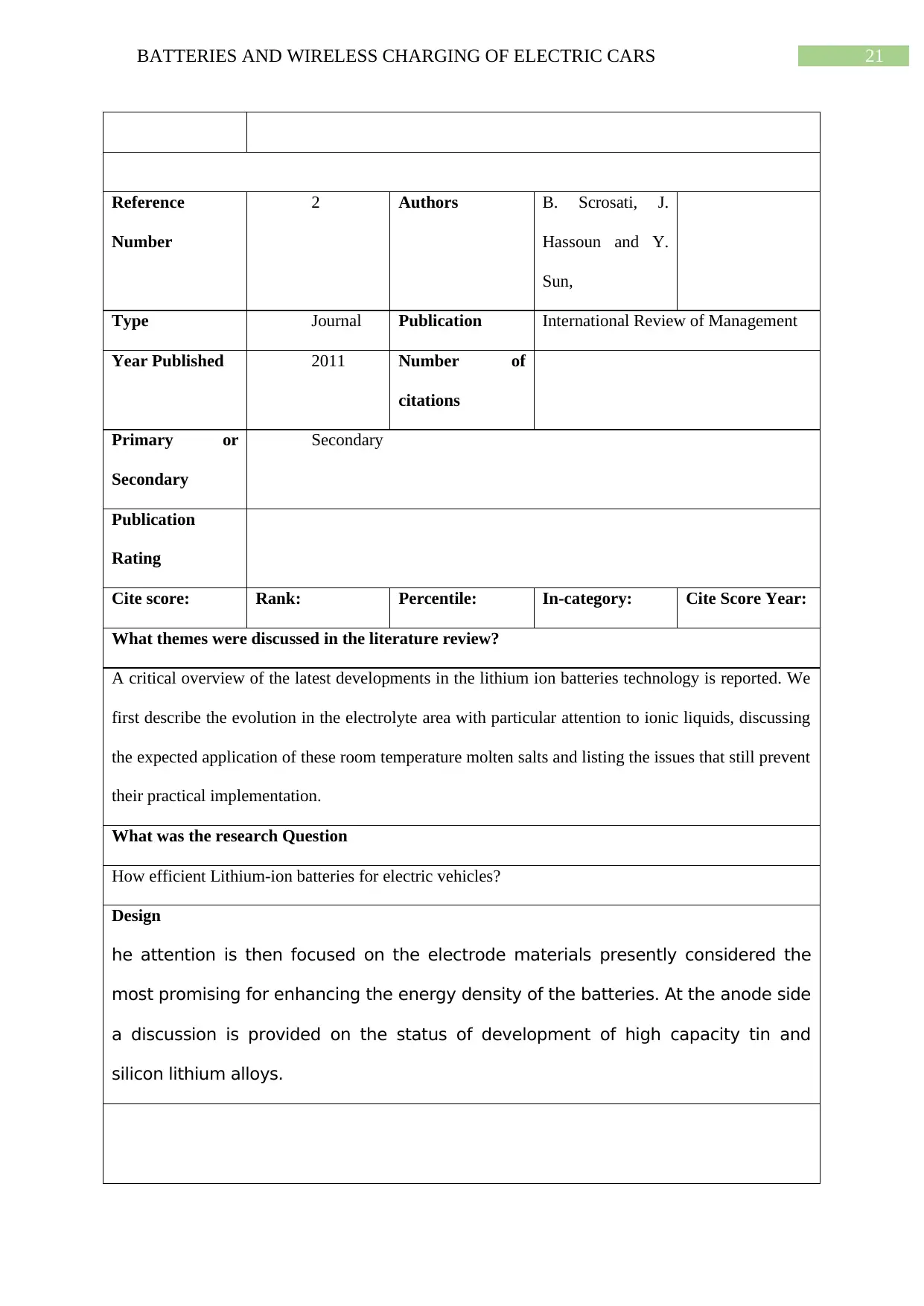
21BATTERIES AND WIRELESS CHARGING OF ELECTRIC CARS
Reference
Number
2 Authors B. Scrosati, J.
Hassoun and Y.
Sun,
Type Journal Publication International Review of Management
Year Published 2011 Number of
citations
Primary or
Secondary
Secondary
Publication
Rating
Cite score: Rank: Percentile: In-category: Cite Score Year:
What themes were discussed in the literature review?
A critical overview of the latest developments in the lithium ion batteries technology is reported. We
first describe the evolution in the electrolyte area with particular attention to ionic liquids, discussing
the expected application of these room temperature molten salts and listing the issues that still prevent
their practical implementation.
What was the research Question
How efficient Lithium-ion batteries for electric vehicles?
Design
he attention is then focused on the electrode materials presently considered the
most promising for enhancing the energy density of the batteries. At the anode side
a discussion is provided on the status of development of high capacity tin and
silicon lithium alloys.
Reference
Number
2 Authors B. Scrosati, J.
Hassoun and Y.
Sun,
Type Journal Publication International Review of Management
Year Published 2011 Number of
citations
Primary or
Secondary
Secondary
Publication
Rating
Cite score: Rank: Percentile: In-category: Cite Score Year:
What themes were discussed in the literature review?
A critical overview of the latest developments in the lithium ion batteries technology is reported. We
first describe the evolution in the electrolyte area with particular attention to ionic liquids, discussing
the expected application of these room temperature molten salts and listing the issues that still prevent
their practical implementation.
What was the research Question
How efficient Lithium-ion batteries for electric vehicles?
Design
he attention is then focused on the electrode materials presently considered the
most promising for enhancing the energy density of the batteries. At the anode side
a discussion is provided on the status of development of high capacity tin and
silicon lithium alloys.
Secure Best Marks with AI Grader
Need help grading? Try our AI Grader for instant feedback on your assignments.
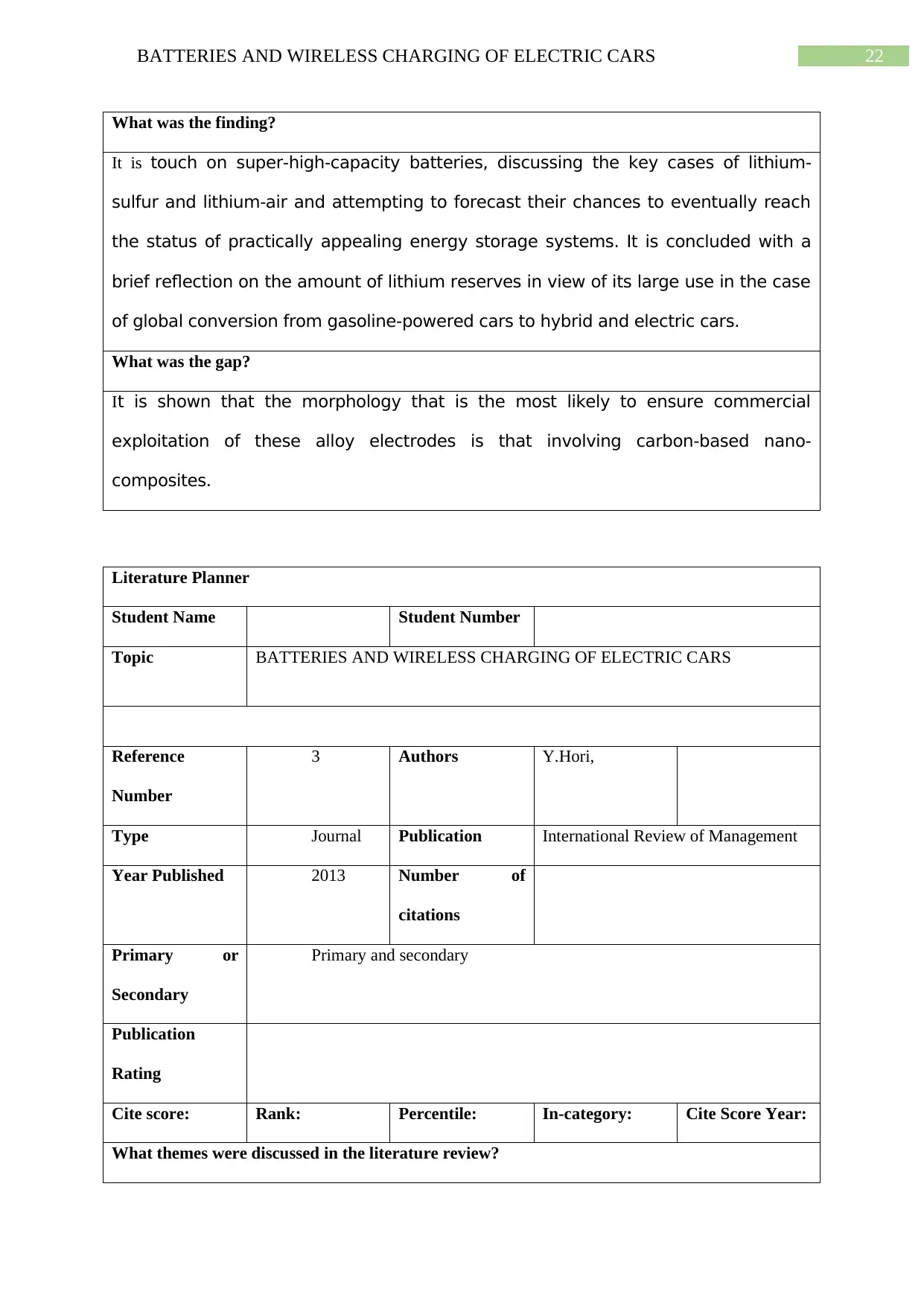
22BATTERIES AND WIRELESS CHARGING OF ELECTRIC CARS
What was the finding?
It is touch on super-high-capacity batteries, discussing the key cases of lithium-
sulfur and lithium-air and attempting to forecast their chances to eventually reach
the status of practically appealing energy storage systems. It is concluded with a
brief reflection on the amount of lithium reserves in view of its large use in the case
of global conversion from gasoline-powered cars to hybrid and electric cars.
What was the gap?
It is shown that the morphology that is the most likely to ensure commercial
exploitation of these alloy electrodes is that involving carbon-based nano-
composites.
Literature Planner
Student Name Student Number
Topic BATTERIES AND WIRELESS CHARGING OF ELECTRIC CARS
Reference
Number
3 Authors Y.Hori,
Type Journal Publication International Review of Management
Year Published 2013 Number of
citations
Primary or
Secondary
Primary and secondary
Publication
Rating
Cite score: Rank: Percentile: In-category: Cite Score Year:
What themes were discussed in the literature review?
What was the finding?
It is touch on super-high-capacity batteries, discussing the key cases of lithium-
sulfur and lithium-air and attempting to forecast their chances to eventually reach
the status of practically appealing energy storage systems. It is concluded with a
brief reflection on the amount of lithium reserves in view of its large use in the case
of global conversion from gasoline-powered cars to hybrid and electric cars.
What was the gap?
It is shown that the morphology that is the most likely to ensure commercial
exploitation of these alloy electrodes is that involving carbon-based nano-
composites.
Literature Planner
Student Name Student Number
Topic BATTERIES AND WIRELESS CHARGING OF ELECTRIC CARS
Reference
Number
3 Authors Y.Hori,
Type Journal Publication International Review of Management
Year Published 2013 Number of
citations
Primary or
Secondary
Primary and secondary
Publication
Rating
Cite score: Rank: Percentile: In-category: Cite Score Year:
What themes were discussed in the literature review?
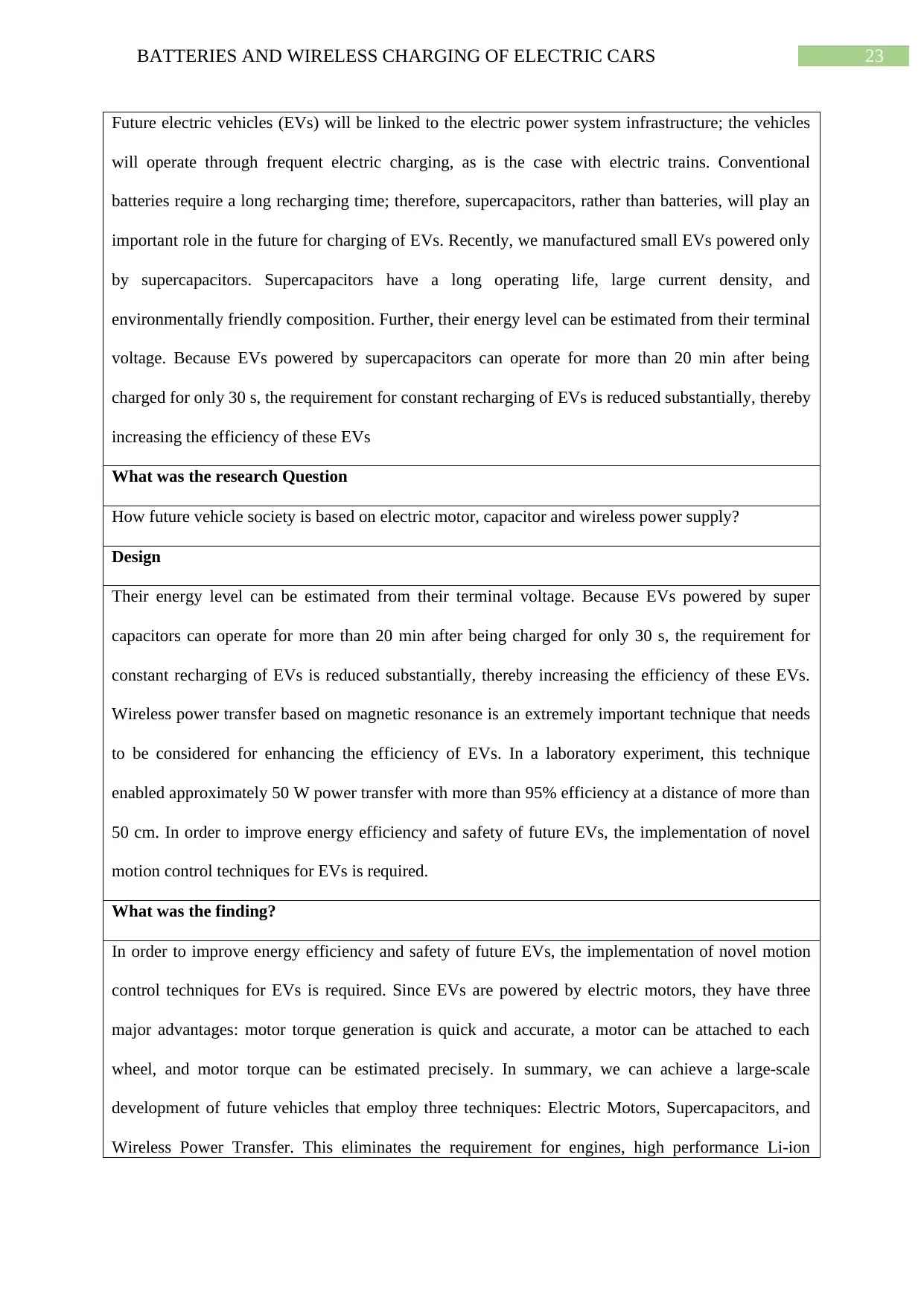
23BATTERIES AND WIRELESS CHARGING OF ELECTRIC CARS
Future electric vehicles (EVs) will be linked to the electric power system infrastructure; the vehicles
will operate through frequent electric charging, as is the case with electric trains. Conventional
batteries require a long recharging time; therefore, supercapacitors, rather than batteries, will play an
important role in the future for charging of EVs. Recently, we manufactured small EVs powered only
by supercapacitors. Supercapacitors have a long operating life, large current density, and
environmentally friendly composition. Further, their energy level can be estimated from their terminal
voltage. Because EVs powered by supercapacitors can operate for more than 20 min after being
charged for only 30 s, the requirement for constant recharging of EVs is reduced substantially, thereby
increasing the efficiency of these EVs
What was the research Question
How future vehicle society is based on electric motor, capacitor and wireless power supply?
Design
Their energy level can be estimated from their terminal voltage. Because EVs powered by super
capacitors can operate for more than 20 min after being charged for only 30 s, the requirement for
constant recharging of EVs is reduced substantially, thereby increasing the efficiency of these EVs.
Wireless power transfer based on magnetic resonance is an extremely important technique that needs
to be considered for enhancing the efficiency of EVs. In a laboratory experiment, this technique
enabled approximately 50 W power transfer with more than 95% efficiency at a distance of more than
50 cm. In order to improve energy efficiency and safety of future EVs, the implementation of novel
motion control techniques for EVs is required.
What was the finding?
In order to improve energy efficiency and safety of future EVs, the implementation of novel motion
control techniques for EVs is required. Since EVs are powered by electric motors, they have three
major advantages: motor torque generation is quick and accurate, a motor can be attached to each
wheel, and motor torque can be estimated precisely. In summary, we can achieve a large-scale
development of future vehicles that employ three techniques: Electric Motors, Supercapacitors, and
Wireless Power Transfer. This eliminates the requirement for engines, high performance Li-ion
Future electric vehicles (EVs) will be linked to the electric power system infrastructure; the vehicles
will operate through frequent electric charging, as is the case with electric trains. Conventional
batteries require a long recharging time; therefore, supercapacitors, rather than batteries, will play an
important role in the future for charging of EVs. Recently, we manufactured small EVs powered only
by supercapacitors. Supercapacitors have a long operating life, large current density, and
environmentally friendly composition. Further, their energy level can be estimated from their terminal
voltage. Because EVs powered by supercapacitors can operate for more than 20 min after being
charged for only 30 s, the requirement for constant recharging of EVs is reduced substantially, thereby
increasing the efficiency of these EVs
What was the research Question
How future vehicle society is based on electric motor, capacitor and wireless power supply?
Design
Their energy level can be estimated from their terminal voltage. Because EVs powered by super
capacitors can operate for more than 20 min after being charged for only 30 s, the requirement for
constant recharging of EVs is reduced substantially, thereby increasing the efficiency of these EVs.
Wireless power transfer based on magnetic resonance is an extremely important technique that needs
to be considered for enhancing the efficiency of EVs. In a laboratory experiment, this technique
enabled approximately 50 W power transfer with more than 95% efficiency at a distance of more than
50 cm. In order to improve energy efficiency and safety of future EVs, the implementation of novel
motion control techniques for EVs is required.
What was the finding?
In order to improve energy efficiency and safety of future EVs, the implementation of novel motion
control techniques for EVs is required. Since EVs are powered by electric motors, they have three
major advantages: motor torque generation is quick and accurate, a motor can be attached to each
wheel, and motor torque can be estimated precisely. In summary, we can achieve a large-scale
development of future vehicles that employ three techniques: Electric Motors, Supercapacitors, and
Wireless Power Transfer. This eliminates the requirement for engines, high performance Li-ion
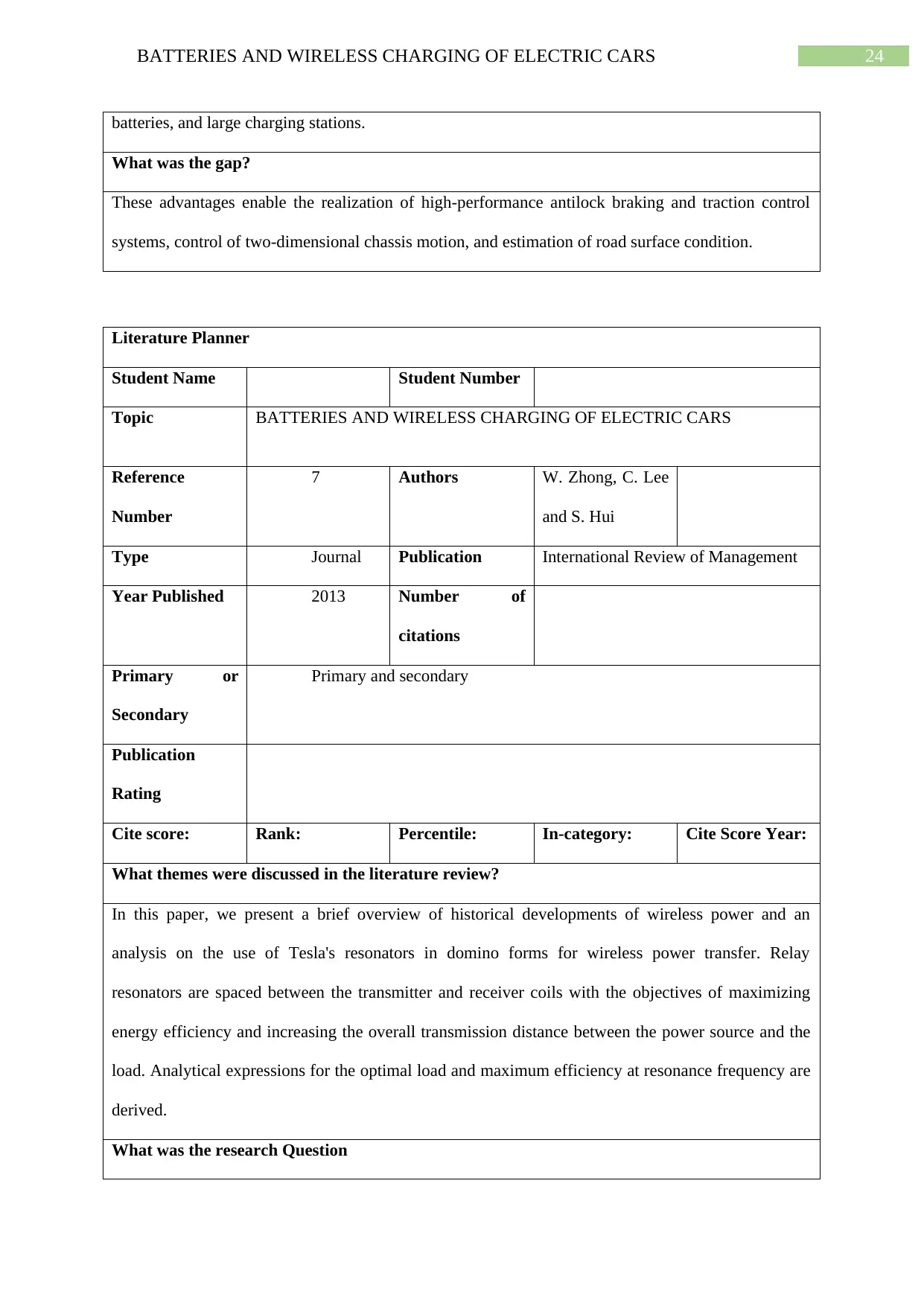
24BATTERIES AND WIRELESS CHARGING OF ELECTRIC CARS
batteries, and large charging stations.
What was the gap?
These advantages enable the realization of high-performance antilock braking and traction control
systems, control of two-dimensional chassis motion, and estimation of road surface condition.
Literature Planner
Student Name Student Number
Topic BATTERIES AND WIRELESS CHARGING OF ELECTRIC CARS
Reference
Number
7 Authors W. Zhong, C. Lee
and S. Hui
Type Journal Publication International Review of Management
Year Published 2013 Number of
citations
Primary or
Secondary
Primary and secondary
Publication
Rating
Cite score: Rank: Percentile: In-category: Cite Score Year:
What themes were discussed in the literature review?
In this paper, we present a brief overview of historical developments of wireless power and an
analysis on the use of Tesla's resonators in domino forms for wireless power transfer. Relay
resonators are spaced between the transmitter and receiver coils with the objectives of maximizing
energy efficiency and increasing the overall transmission distance between the power source and the
load. Analytical expressions for the optimal load and maximum efficiency at resonance frequency are
derived.
What was the research Question
batteries, and large charging stations.
What was the gap?
These advantages enable the realization of high-performance antilock braking and traction control
systems, control of two-dimensional chassis motion, and estimation of road surface condition.
Literature Planner
Student Name Student Number
Topic BATTERIES AND WIRELESS CHARGING OF ELECTRIC CARS
Reference
Number
7 Authors W. Zhong, C. Lee
and S. Hui
Type Journal Publication International Review of Management
Year Published 2013 Number of
citations
Primary or
Secondary
Primary and secondary
Publication
Rating
Cite score: Rank: Percentile: In-category: Cite Score Year:
What themes were discussed in the literature review?
In this paper, we present a brief overview of historical developments of wireless power and an
analysis on the use of Tesla's resonators in domino forms for wireless power transfer. Relay
resonators are spaced between the transmitter and receiver coils with the objectives of maximizing
energy efficiency and increasing the overall transmission distance between the power source and the
load. Analytical expressions for the optimal load and maximum efficiency at resonance frequency are
derived.
What was the research Question
Paraphrase This Document
Need a fresh take? Get an instant paraphrase of this document with our AI Paraphraser
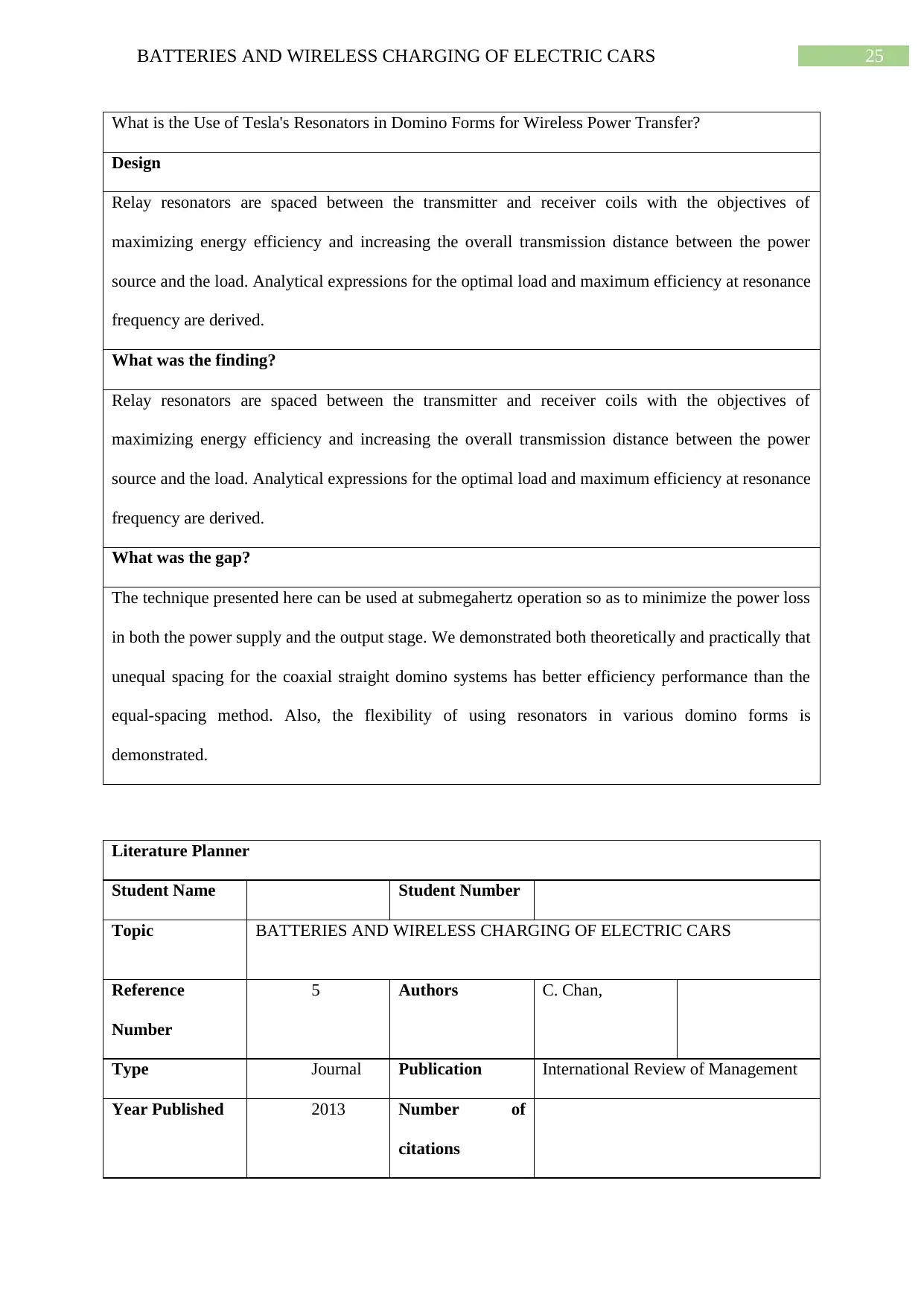
25BATTERIES AND WIRELESS CHARGING OF ELECTRIC CARS
What is the Use of Tesla's Resonators in Domino Forms for Wireless Power Transfer?
Design
Relay resonators are spaced between the transmitter and receiver coils with the objectives of
maximizing energy efficiency and increasing the overall transmission distance between the power
source and the load. Analytical expressions for the optimal load and maximum efficiency at resonance
frequency are derived.
What was the finding?
Relay resonators are spaced between the transmitter and receiver coils with the objectives of
maximizing energy efficiency and increasing the overall transmission distance between the power
source and the load. Analytical expressions for the optimal load and maximum efficiency at resonance
frequency are derived.
What was the gap?
The technique presented here can be used at submegahertz operation so as to minimize the power loss
in both the power supply and the output stage. We demonstrated both theoretically and practically that
unequal spacing for the coaxial straight domino systems has better efficiency performance than the
equal-spacing method. Also, the flexibility of using resonators in various domino forms is
demonstrated.
Literature Planner
Student Name Student Number
Topic BATTERIES AND WIRELESS CHARGING OF ELECTRIC CARS
Reference
Number
5 Authors C. Chan,
Type Journal Publication International Review of Management
Year Published 2013 Number of
citations
What is the Use of Tesla's Resonators in Domino Forms for Wireless Power Transfer?
Design
Relay resonators are spaced between the transmitter and receiver coils with the objectives of
maximizing energy efficiency and increasing the overall transmission distance between the power
source and the load. Analytical expressions for the optimal load and maximum efficiency at resonance
frequency are derived.
What was the finding?
Relay resonators are spaced between the transmitter and receiver coils with the objectives of
maximizing energy efficiency and increasing the overall transmission distance between the power
source and the load. Analytical expressions for the optimal load and maximum efficiency at resonance
frequency are derived.
What was the gap?
The technique presented here can be used at submegahertz operation so as to minimize the power loss
in both the power supply and the output stage. We demonstrated both theoretically and practically that
unequal spacing for the coaxial straight domino systems has better efficiency performance than the
equal-spacing method. Also, the flexibility of using resonators in various domino forms is
demonstrated.
Literature Planner
Student Name Student Number
Topic BATTERIES AND WIRELESS CHARGING OF ELECTRIC CARS
Reference
Number
5 Authors C. Chan,
Type Journal Publication International Review of Management
Year Published 2013 Number of
citations
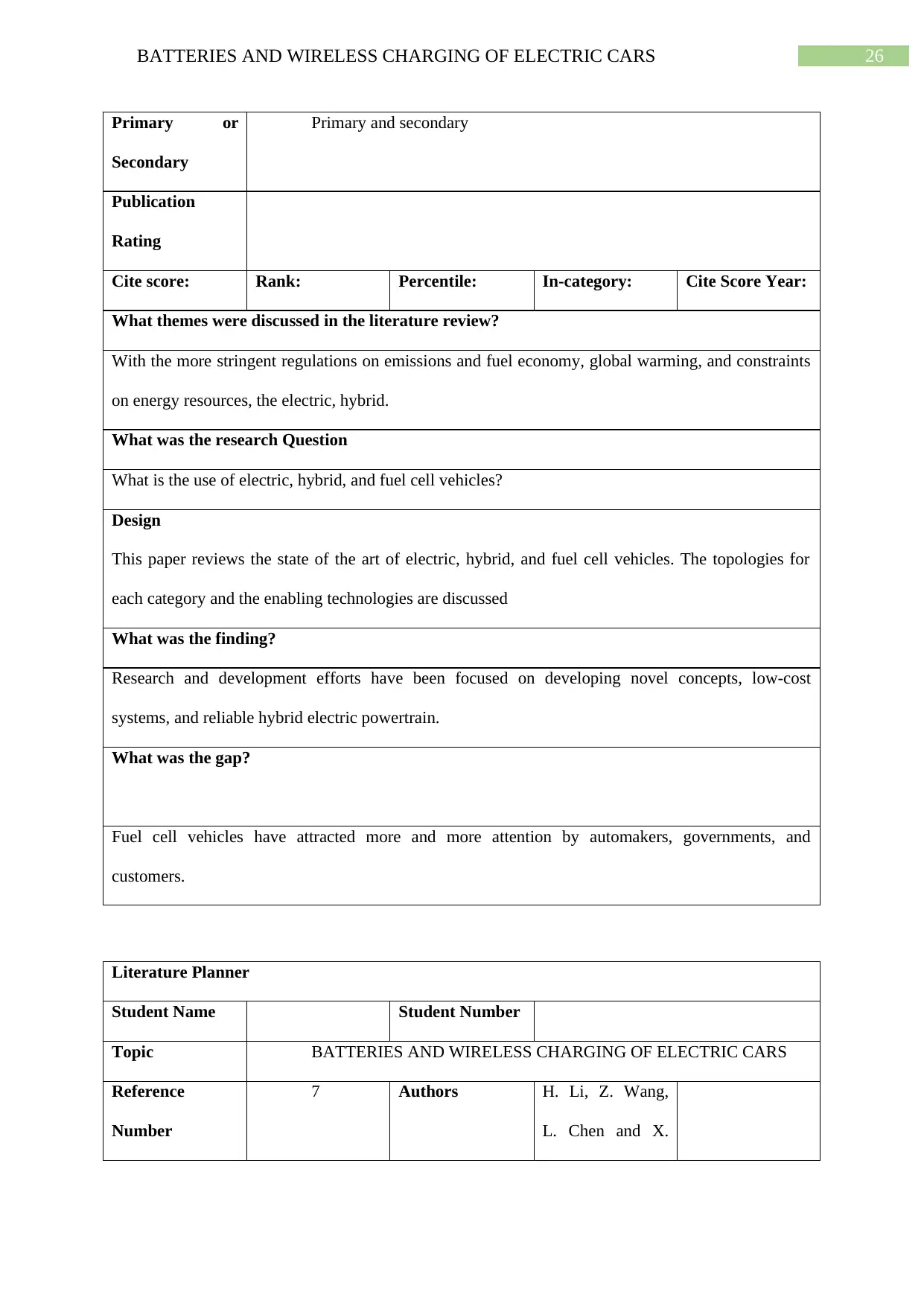
26BATTERIES AND WIRELESS CHARGING OF ELECTRIC CARS
Primary or
Secondary
Primary and secondary
Publication
Rating
Cite score: Rank: Percentile: In-category: Cite Score Year:
What themes were discussed in the literature review?
With the more stringent regulations on emissions and fuel economy, global warming, and constraints
on energy resources, the electric, hybrid.
What was the research Question
What is the use of electric, hybrid, and fuel cell vehicles?
Design
This paper reviews the state of the art of electric, hybrid, and fuel cell vehicles. The topologies for
each category and the enabling technologies are discussed
What was the finding?
Research and development efforts have been focused on developing novel concepts, low-cost
systems, and reliable hybrid electric powertrain.
What was the gap?
Fuel cell vehicles have attracted more and more attention by automakers, governments, and
customers.
Literature Planner
Student Name Student Number
Topic BATTERIES AND WIRELESS CHARGING OF ELECTRIC CARS
Reference
Number
7 Authors H. Li, Z. Wang,
L. Chen and X.
Primary or
Secondary
Primary and secondary
Publication
Rating
Cite score: Rank: Percentile: In-category: Cite Score Year:
What themes were discussed in the literature review?
With the more stringent regulations on emissions and fuel economy, global warming, and constraints
on energy resources, the electric, hybrid.
What was the research Question
What is the use of electric, hybrid, and fuel cell vehicles?
Design
This paper reviews the state of the art of electric, hybrid, and fuel cell vehicles. The topologies for
each category and the enabling technologies are discussed
What was the finding?
Research and development efforts have been focused on developing novel concepts, low-cost
systems, and reliable hybrid electric powertrain.
What was the gap?
Fuel cell vehicles have attracted more and more attention by automakers, governments, and
customers.
Literature Planner
Student Name Student Number
Topic BATTERIES AND WIRELESS CHARGING OF ELECTRIC CARS
Reference
Number
7 Authors H. Li, Z. Wang,
L. Chen and X.
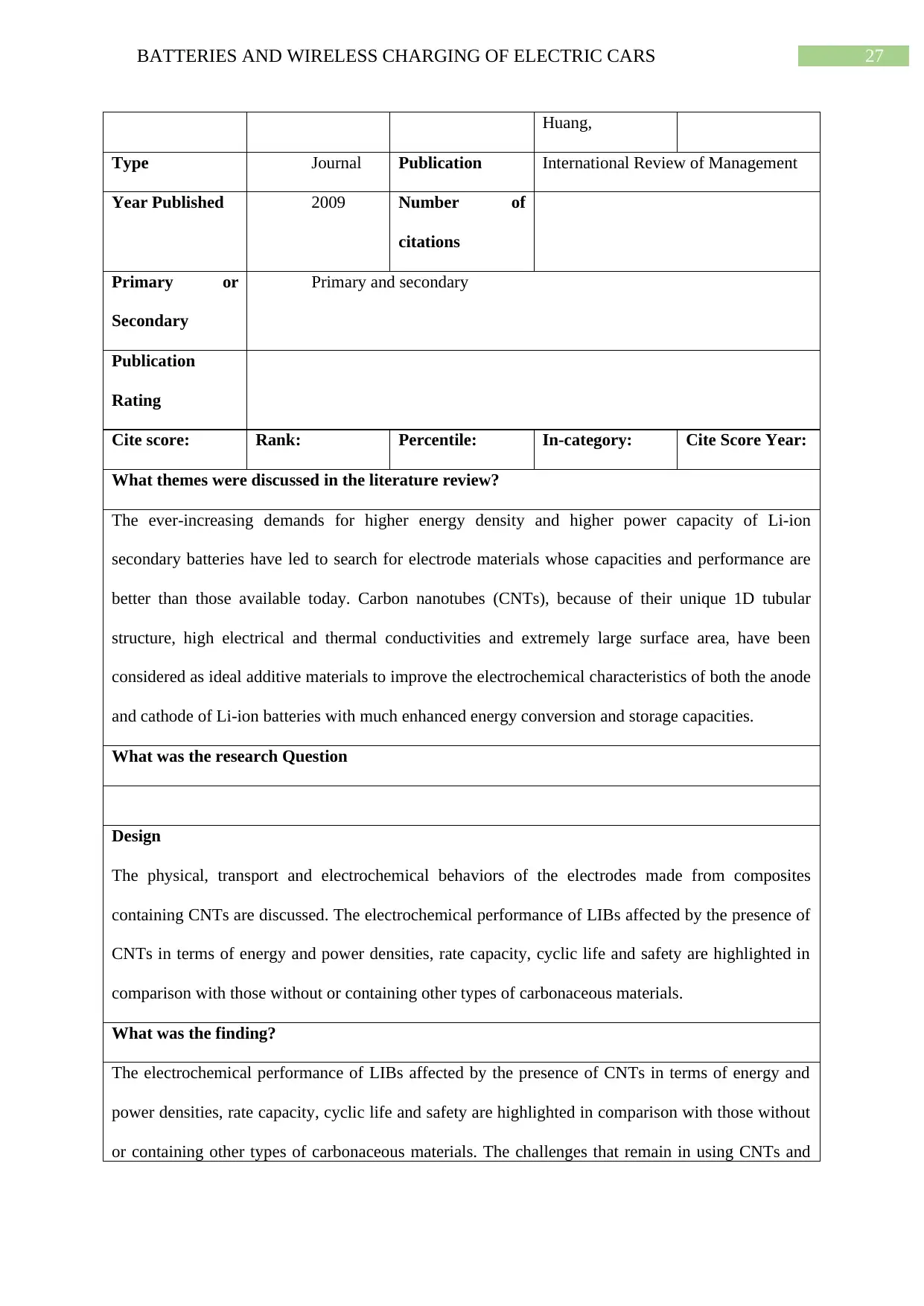
27BATTERIES AND WIRELESS CHARGING OF ELECTRIC CARS
Huang,
Type Journal Publication International Review of Management
Year Published 2009 Number of
citations
Primary or
Secondary
Primary and secondary
Publication
Rating
Cite score: Rank: Percentile: In-category: Cite Score Year:
What themes were discussed in the literature review?
The ever-increasing demands for higher energy density and higher power capacity of Li-ion
secondary batteries have led to search for electrode materials whose capacities and performance are
better than those available today. Carbon nanotubes (CNTs), because of their unique 1D tubular
structure, high electrical and thermal conductivities and extremely large surface area, have been
considered as ideal additive materials to improve the electrochemical characteristics of both the anode
and cathode of Li-ion batteries with much enhanced energy conversion and storage capacities.
What was the research Question
Design
The physical, transport and electrochemical behaviors of the electrodes made from composites
containing CNTs are discussed. The electrochemical performance of LIBs affected by the presence of
CNTs in terms of energy and power densities, rate capacity, cyclic life and safety are highlighted in
comparison with those without or containing other types of carbonaceous materials.
What was the finding?
The electrochemical performance of LIBs affected by the presence of CNTs in terms of energy and
power densities, rate capacity, cyclic life and safety are highlighted in comparison with those without
or containing other types of carbonaceous materials. The challenges that remain in using CNTs and
Huang,
Type Journal Publication International Review of Management
Year Published 2009 Number of
citations
Primary or
Secondary
Primary and secondary
Publication
Rating
Cite score: Rank: Percentile: In-category: Cite Score Year:
What themes were discussed in the literature review?
The ever-increasing demands for higher energy density and higher power capacity of Li-ion
secondary batteries have led to search for electrode materials whose capacities and performance are
better than those available today. Carbon nanotubes (CNTs), because of their unique 1D tubular
structure, high electrical and thermal conductivities and extremely large surface area, have been
considered as ideal additive materials to improve the electrochemical characteristics of both the anode
and cathode of Li-ion batteries with much enhanced energy conversion and storage capacities.
What was the research Question
Design
The physical, transport and electrochemical behaviors of the electrodes made from composites
containing CNTs are discussed. The electrochemical performance of LIBs affected by the presence of
CNTs in terms of energy and power densities, rate capacity, cyclic life and safety are highlighted in
comparison with those without or containing other types of carbonaceous materials.
What was the finding?
The electrochemical performance of LIBs affected by the presence of CNTs in terms of energy and
power densities, rate capacity, cyclic life and safety are highlighted in comparison with those without
or containing other types of carbonaceous materials. The challenges that remain in using CNTs and
Secure Best Marks with AI Grader
Need help grading? Try our AI Grader for instant feedback on your assignments.
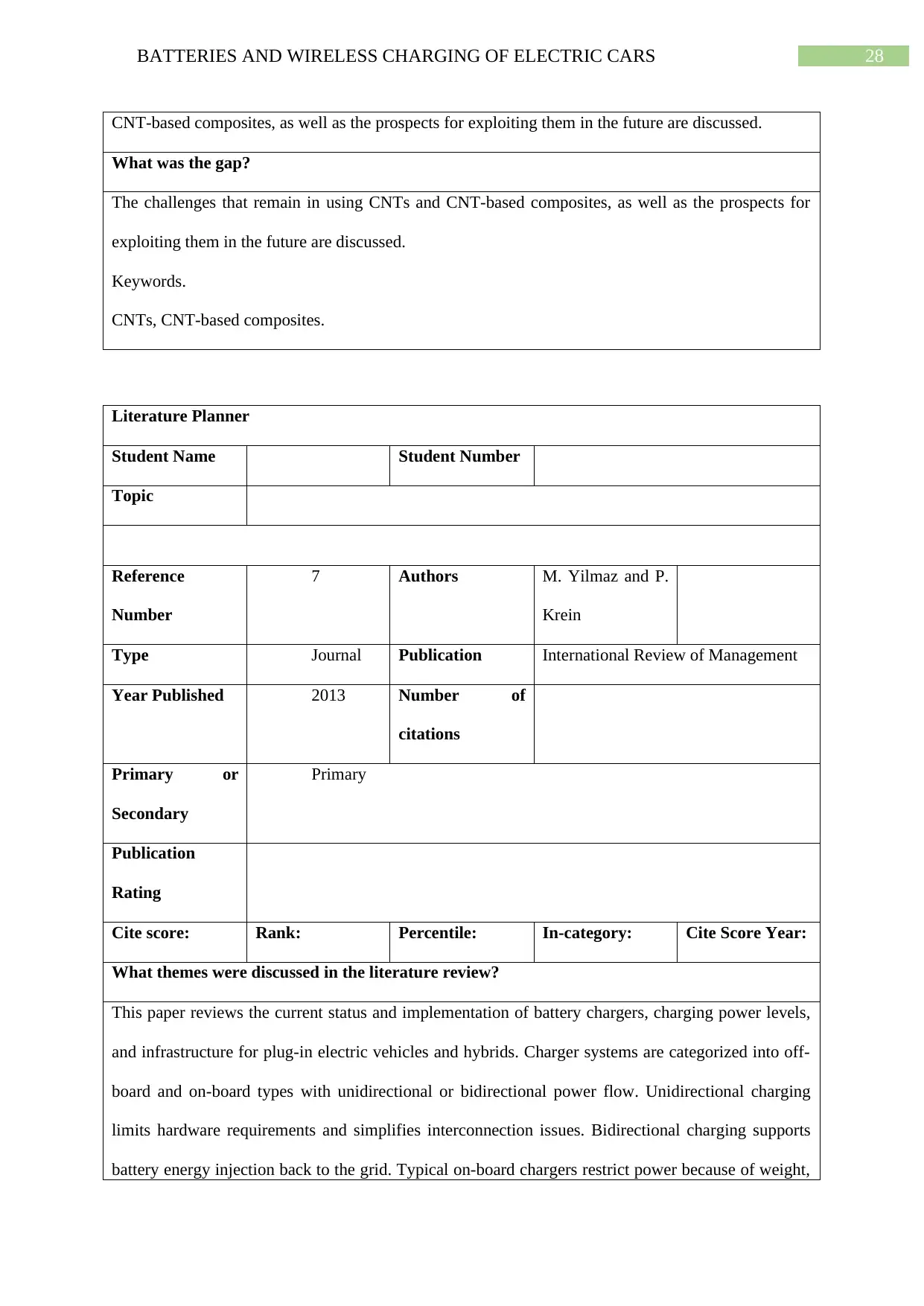
28BATTERIES AND WIRELESS CHARGING OF ELECTRIC CARS
CNT-based composites, as well as the prospects for exploiting them in the future are discussed.
What was the gap?
The challenges that remain in using CNTs and CNT-based composites, as well as the prospects for
exploiting them in the future are discussed.
Keywords.
CNTs, CNT-based composites.
Literature Planner
Student Name Student Number
Topic
Reference
Number
7 Authors M. Yilmaz and P.
Krein
Type Journal Publication International Review of Management
Year Published 2013 Number of
citations
Primary or
Secondary
Primary
Publication
Rating
Cite score: Rank: Percentile: In-category: Cite Score Year:
What themes were discussed in the literature review?
This paper reviews the current status and implementation of battery chargers, charging power levels,
and infrastructure for plug-in electric vehicles and hybrids. Charger systems are categorized into off-
board and on-board types with unidirectional or bidirectional power flow. Unidirectional charging
limits hardware requirements and simplifies interconnection issues. Bidirectional charging supports
battery energy injection back to the grid. Typical on-board chargers restrict power because of weight,
CNT-based composites, as well as the prospects for exploiting them in the future are discussed.
What was the gap?
The challenges that remain in using CNTs and CNT-based composites, as well as the prospects for
exploiting them in the future are discussed.
Keywords.
CNTs, CNT-based composites.
Literature Planner
Student Name Student Number
Topic
Reference
Number
7 Authors M. Yilmaz and P.
Krein
Type Journal Publication International Review of Management
Year Published 2013 Number of
citations
Primary or
Secondary
Primary
Publication
Rating
Cite score: Rank: Percentile: In-category: Cite Score Year:
What themes were discussed in the literature review?
This paper reviews the current status and implementation of battery chargers, charging power levels,
and infrastructure for plug-in electric vehicles and hybrids. Charger systems are categorized into off-
board and on-board types with unidirectional or bidirectional power flow. Unidirectional charging
limits hardware requirements and simplifies interconnection issues. Bidirectional charging supports
battery energy injection back to the grid. Typical on-board chargers restrict power because of weight,
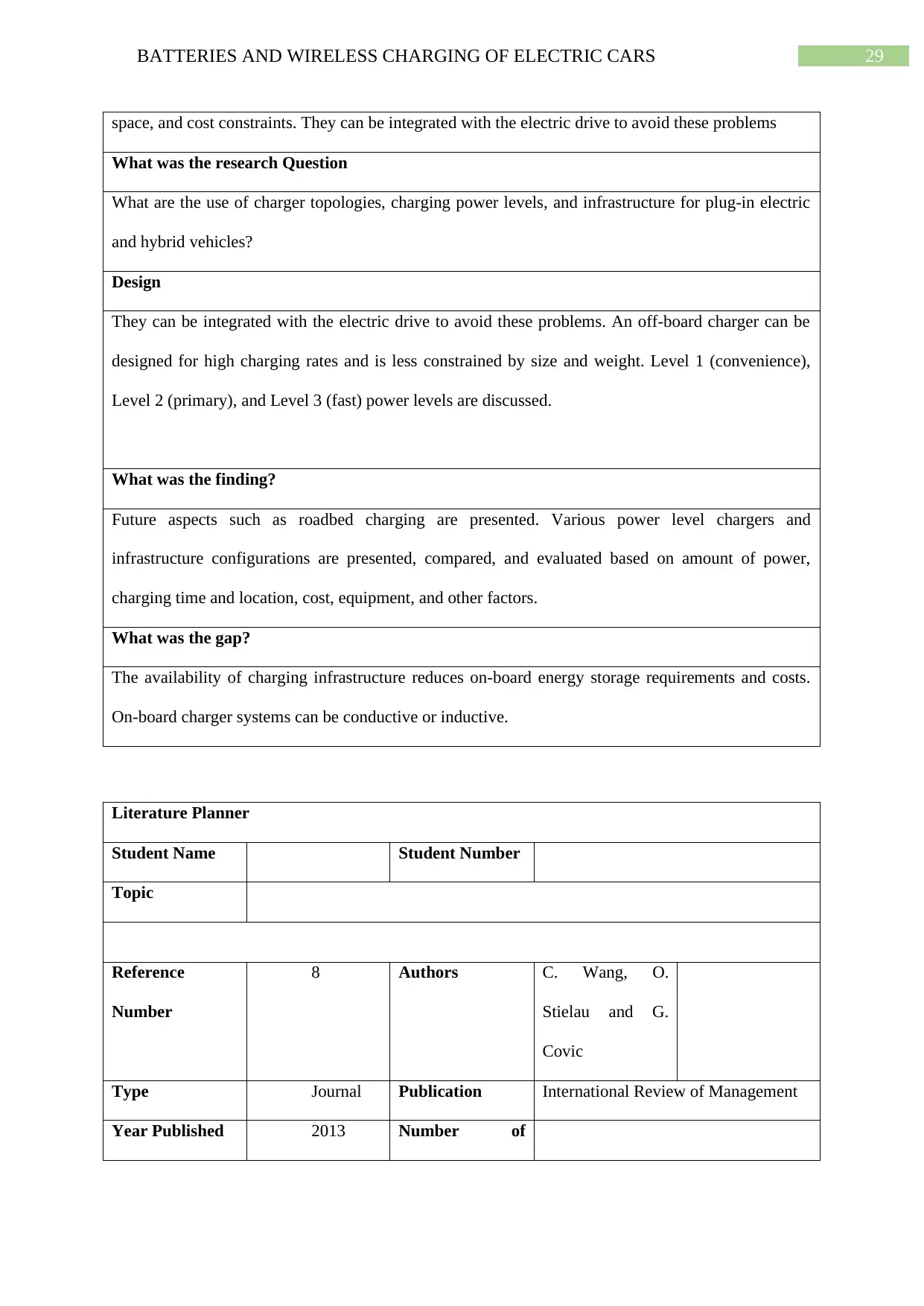
29BATTERIES AND WIRELESS CHARGING OF ELECTRIC CARS
space, and cost constraints. They can be integrated with the electric drive to avoid these problems
What was the research Question
What are the use of charger topologies, charging power levels, and infrastructure for plug-in electric
and hybrid vehicles?
Design
They can be integrated with the electric drive to avoid these problems. An off-board charger can be
designed for high charging rates and is less constrained by size and weight. Level 1 (convenience),
Level 2 (primary), and Level 3 (fast) power levels are discussed.
What was the finding?
Future aspects such as roadbed charging are presented. Various power level chargers and
infrastructure configurations are presented, compared, and evaluated based on amount of power,
charging time and location, cost, equipment, and other factors.
What was the gap?
The availability of charging infrastructure reduces on-board energy storage requirements and costs.
On-board charger systems can be conductive or inductive.
Literature Planner
Student Name Student Number
Topic
Reference
Number
8 Authors C. Wang, O.
Stielau and G.
Covic
Type Journal Publication International Review of Management
Year Published 2013 Number of
space, and cost constraints. They can be integrated with the electric drive to avoid these problems
What was the research Question
What are the use of charger topologies, charging power levels, and infrastructure for plug-in electric
and hybrid vehicles?
Design
They can be integrated with the electric drive to avoid these problems. An off-board charger can be
designed for high charging rates and is less constrained by size and weight. Level 1 (convenience),
Level 2 (primary), and Level 3 (fast) power levels are discussed.
What was the finding?
Future aspects such as roadbed charging are presented. Various power level chargers and
infrastructure configurations are presented, compared, and evaluated based on amount of power,
charging time and location, cost, equipment, and other factors.
What was the gap?
The availability of charging infrastructure reduces on-board energy storage requirements and costs.
On-board charger systems can be conductive or inductive.
Literature Planner
Student Name Student Number
Topic
Reference
Number
8 Authors C. Wang, O.
Stielau and G.
Covic
Type Journal Publication International Review of Management
Year Published 2013 Number of
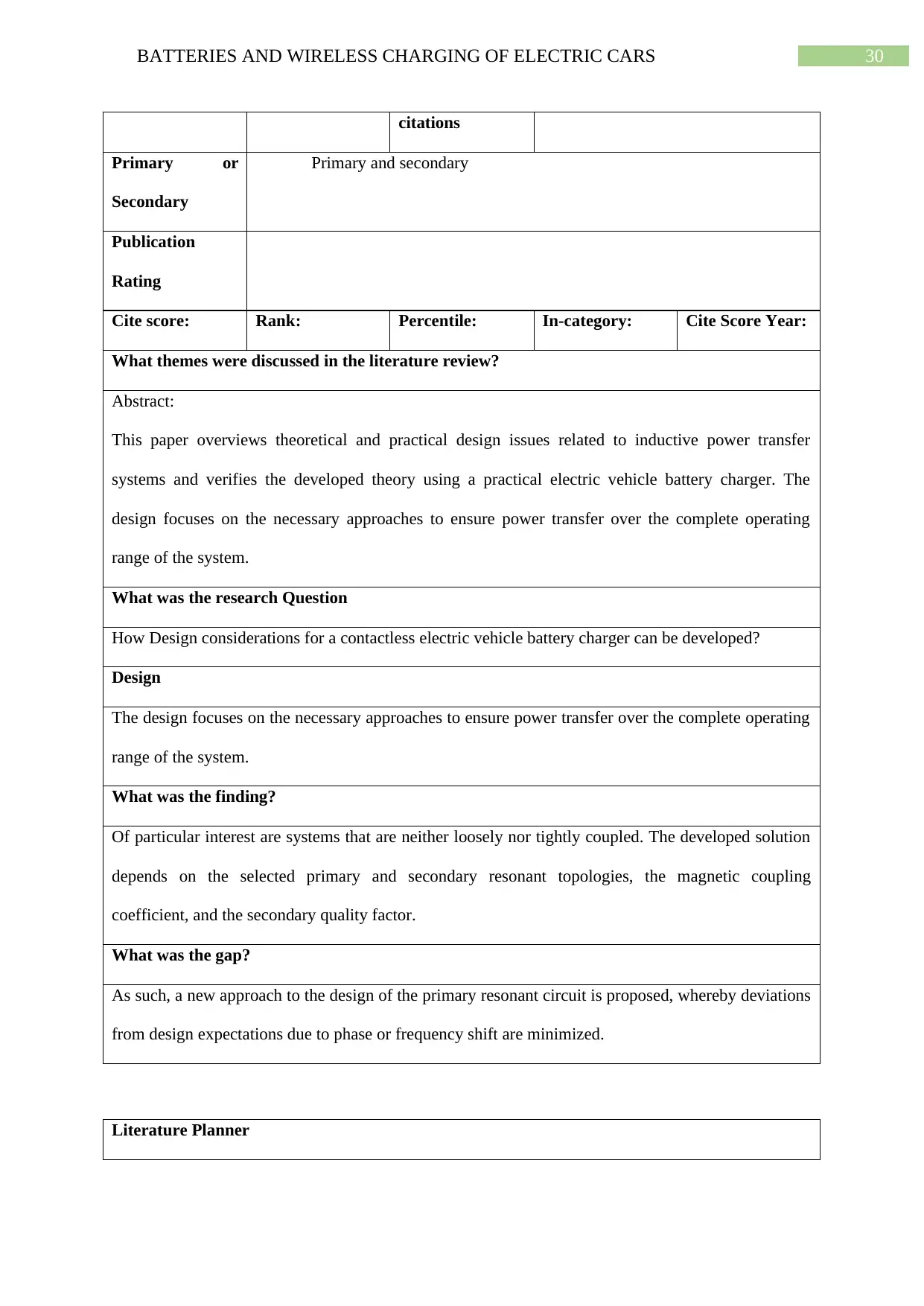
30BATTERIES AND WIRELESS CHARGING OF ELECTRIC CARS
citations
Primary or
Secondary
Primary and secondary
Publication
Rating
Cite score: Rank: Percentile: In-category: Cite Score Year:
What themes were discussed in the literature review?
Abstract:
This paper overviews theoretical and practical design issues related to inductive power transfer
systems and verifies the developed theory using a practical electric vehicle battery charger. The
design focuses on the necessary approaches to ensure power transfer over the complete operating
range of the system.
What was the research Question
How Design considerations for a contactless electric vehicle battery charger can be developed?
Design
The design focuses on the necessary approaches to ensure power transfer over the complete operating
range of the system.
What was the finding?
Of particular interest are systems that are neither loosely nor tightly coupled. The developed solution
depends on the selected primary and secondary resonant topologies, the magnetic coupling
coefficient, and the secondary quality factor.
What was the gap?
As such, a new approach to the design of the primary resonant circuit is proposed, whereby deviations
from design expectations due to phase or frequency shift are minimized.
Literature Planner
citations
Primary or
Secondary
Primary and secondary
Publication
Rating
Cite score: Rank: Percentile: In-category: Cite Score Year:
What themes were discussed in the literature review?
Abstract:
This paper overviews theoretical and practical design issues related to inductive power transfer
systems and verifies the developed theory using a practical electric vehicle battery charger. The
design focuses on the necessary approaches to ensure power transfer over the complete operating
range of the system.
What was the research Question
How Design considerations for a contactless electric vehicle battery charger can be developed?
Design
The design focuses on the necessary approaches to ensure power transfer over the complete operating
range of the system.
What was the finding?
Of particular interest are systems that are neither loosely nor tightly coupled. The developed solution
depends on the selected primary and secondary resonant topologies, the magnetic coupling
coefficient, and the secondary quality factor.
What was the gap?
As such, a new approach to the design of the primary resonant circuit is proposed, whereby deviations
from design expectations due to phase or frequency shift are minimized.
Literature Planner
Paraphrase This Document
Need a fresh take? Get an instant paraphrase of this document with our AI Paraphraser
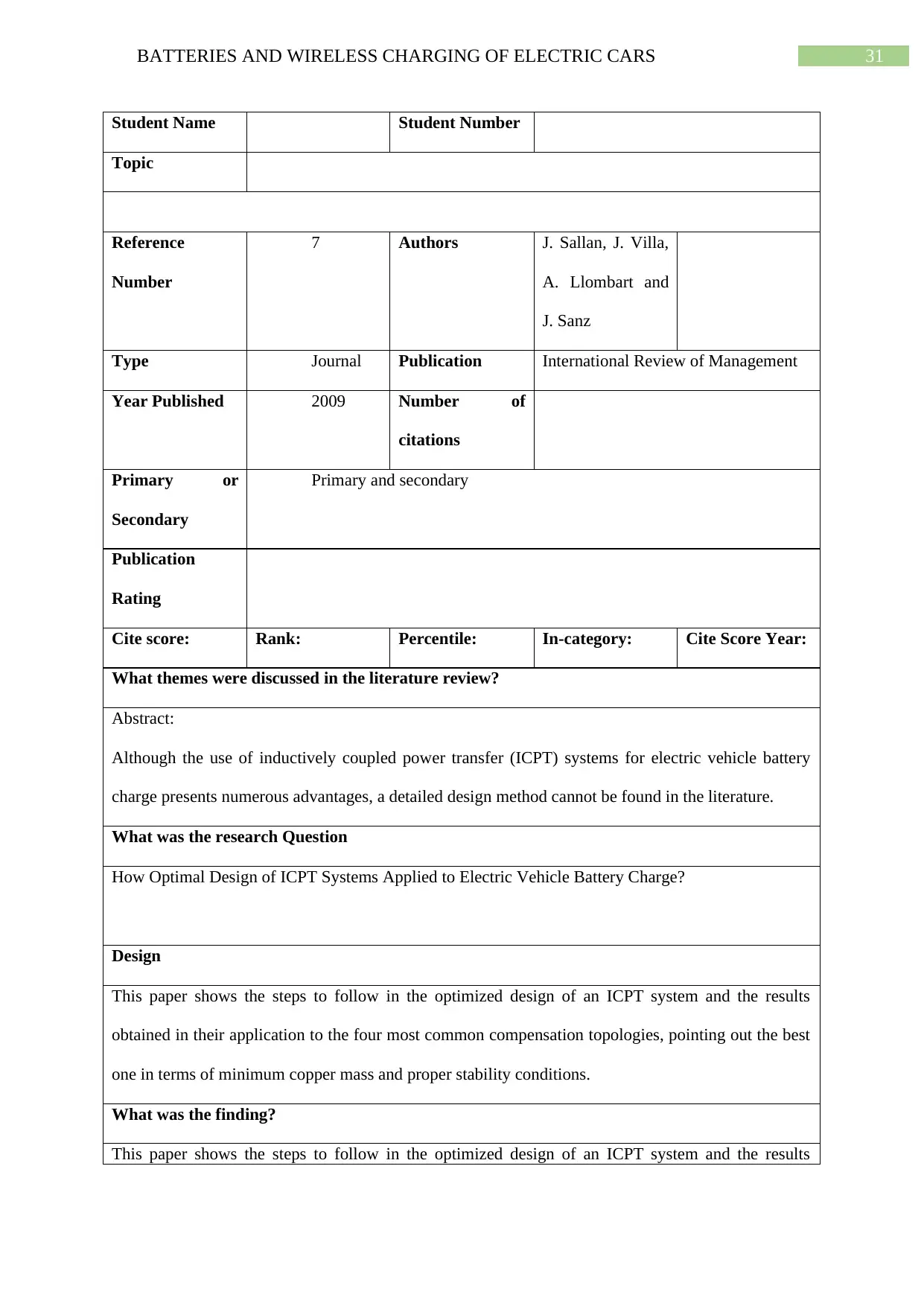
31BATTERIES AND WIRELESS CHARGING OF ELECTRIC CARS
Student Name Student Number
Topic
Reference
Number
7 Authors J. Sallan, J. Villa,
A. Llombart and
J. Sanz
Type Journal Publication International Review of Management
Year Published 2009 Number of
citations
Primary or
Secondary
Primary and secondary
Publication
Rating
Cite score: Rank: Percentile: In-category: Cite Score Year:
What themes were discussed in the literature review?
Abstract:
Although the use of inductively coupled power transfer (ICPT) systems for electric vehicle battery
charge presents numerous advantages, a detailed design method cannot be found in the literature.
What was the research Question
How Optimal Design of ICPT Systems Applied to Electric Vehicle Battery Charge?
Design
This paper shows the steps to follow in the optimized design of an ICPT system and the results
obtained in their application to the four most common compensation topologies, pointing out the best
one in terms of minimum copper mass and proper stability conditions.
What was the finding?
This paper shows the steps to follow in the optimized design of an ICPT system and the results
Student Name Student Number
Topic
Reference
Number
7 Authors J. Sallan, J. Villa,
A. Llombart and
J. Sanz
Type Journal Publication International Review of Management
Year Published 2009 Number of
citations
Primary or
Secondary
Primary and secondary
Publication
Rating
Cite score: Rank: Percentile: In-category: Cite Score Year:
What themes were discussed in the literature review?
Abstract:
Although the use of inductively coupled power transfer (ICPT) systems for electric vehicle battery
charge presents numerous advantages, a detailed design method cannot be found in the literature.
What was the research Question
How Optimal Design of ICPT Systems Applied to Electric Vehicle Battery Charge?
Design
This paper shows the steps to follow in the optimized design of an ICPT system and the results
obtained in their application to the four most common compensation topologies, pointing out the best
one in terms of minimum copper mass and proper stability conditions.
What was the finding?
This paper shows the steps to follow in the optimized design of an ICPT system and the results
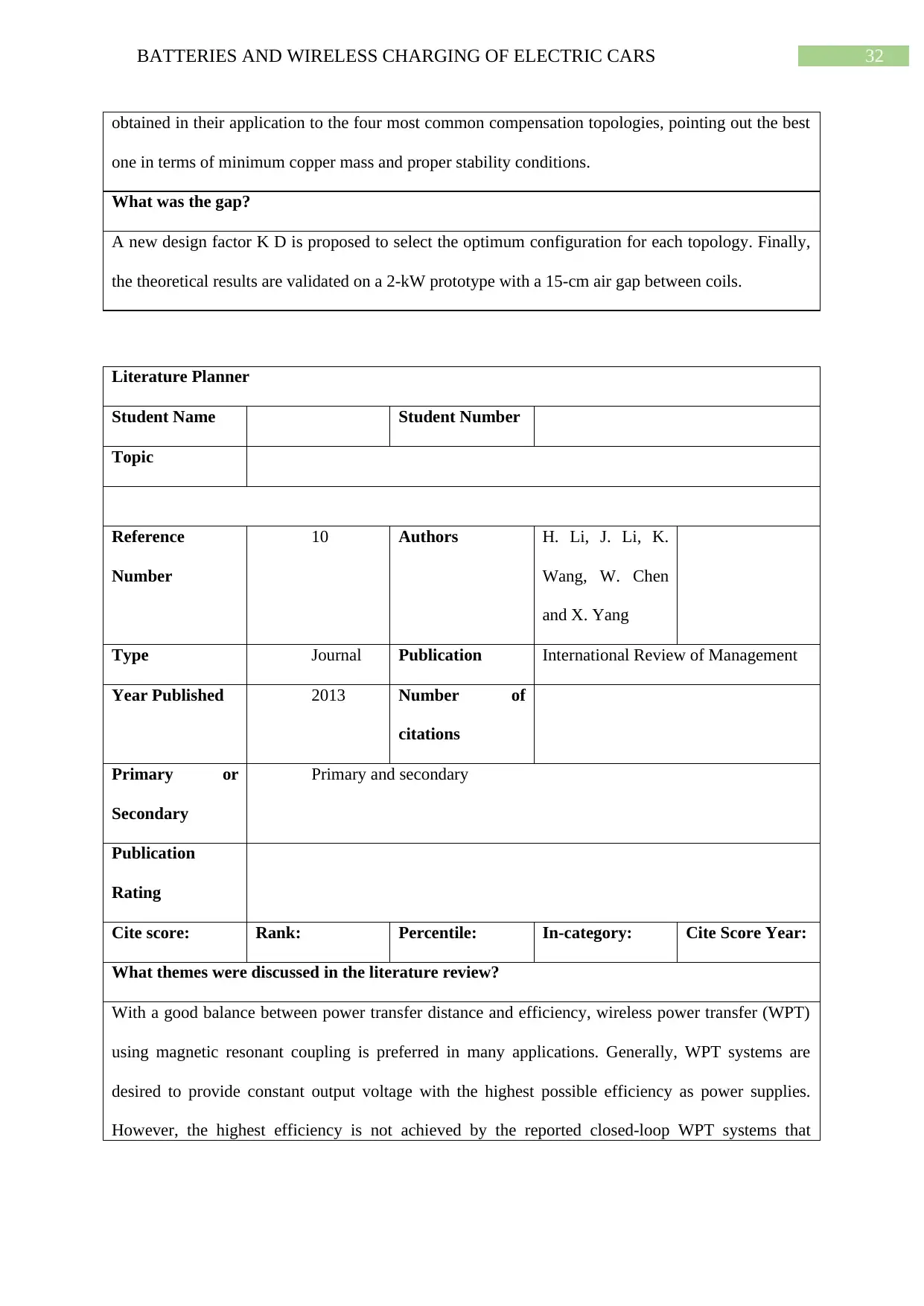
32BATTERIES AND WIRELESS CHARGING OF ELECTRIC CARS
obtained in their application to the four most common compensation topologies, pointing out the best
one in terms of minimum copper mass and proper stability conditions.
What was the gap?
A new design factor K D is proposed to select the optimum configuration for each topology. Finally,
the theoretical results are validated on a 2-kW prototype with a 15-cm air gap between coils.
Literature Planner
Student Name Student Number
Topic
Reference
Number
10 Authors H. Li, J. Li, K.
Wang, W. Chen
and X. Yang
Type Journal Publication International Review of Management
Year Published 2013 Number of
citations
Primary or
Secondary
Primary and secondary
Publication
Rating
Cite score: Rank: Percentile: In-category: Cite Score Year:
What themes were discussed in the literature review?
With a good balance between power transfer distance and efficiency, wireless power transfer (WPT)
using magnetic resonant coupling is preferred in many applications. Generally, WPT systems are
desired to provide constant output voltage with the highest possible efficiency as power supplies.
However, the highest efficiency is not achieved by the reported closed-loop WPT systems that
obtained in their application to the four most common compensation topologies, pointing out the best
one in terms of minimum copper mass and proper stability conditions.
What was the gap?
A new design factor K D is proposed to select the optimum configuration for each topology. Finally,
the theoretical results are validated on a 2-kW prototype with a 15-cm air gap between coils.
Literature Planner
Student Name Student Number
Topic
Reference
Number
10 Authors H. Li, J. Li, K.
Wang, W. Chen
and X. Yang
Type Journal Publication International Review of Management
Year Published 2013 Number of
citations
Primary or
Secondary
Primary and secondary
Publication
Rating
Cite score: Rank: Percentile: In-category: Cite Score Year:
What themes were discussed in the literature review?
With a good balance between power transfer distance and efficiency, wireless power transfer (WPT)
using magnetic resonant coupling is preferred in many applications. Generally, WPT systems are
desired to provide constant output voltage with the highest possible efficiency as power supplies.
However, the highest efficiency is not achieved by the reported closed-loop WPT systems that
1 out of 33
Related Documents
Your All-in-One AI-Powered Toolkit for Academic Success.
+13062052269
info@desklib.com
Available 24*7 on WhatsApp / Email
![[object Object]](/_next/static/media/star-bottom.7253800d.svg)
Unlock your academic potential
© 2024 | Zucol Services PVT LTD | All rights reserved.





